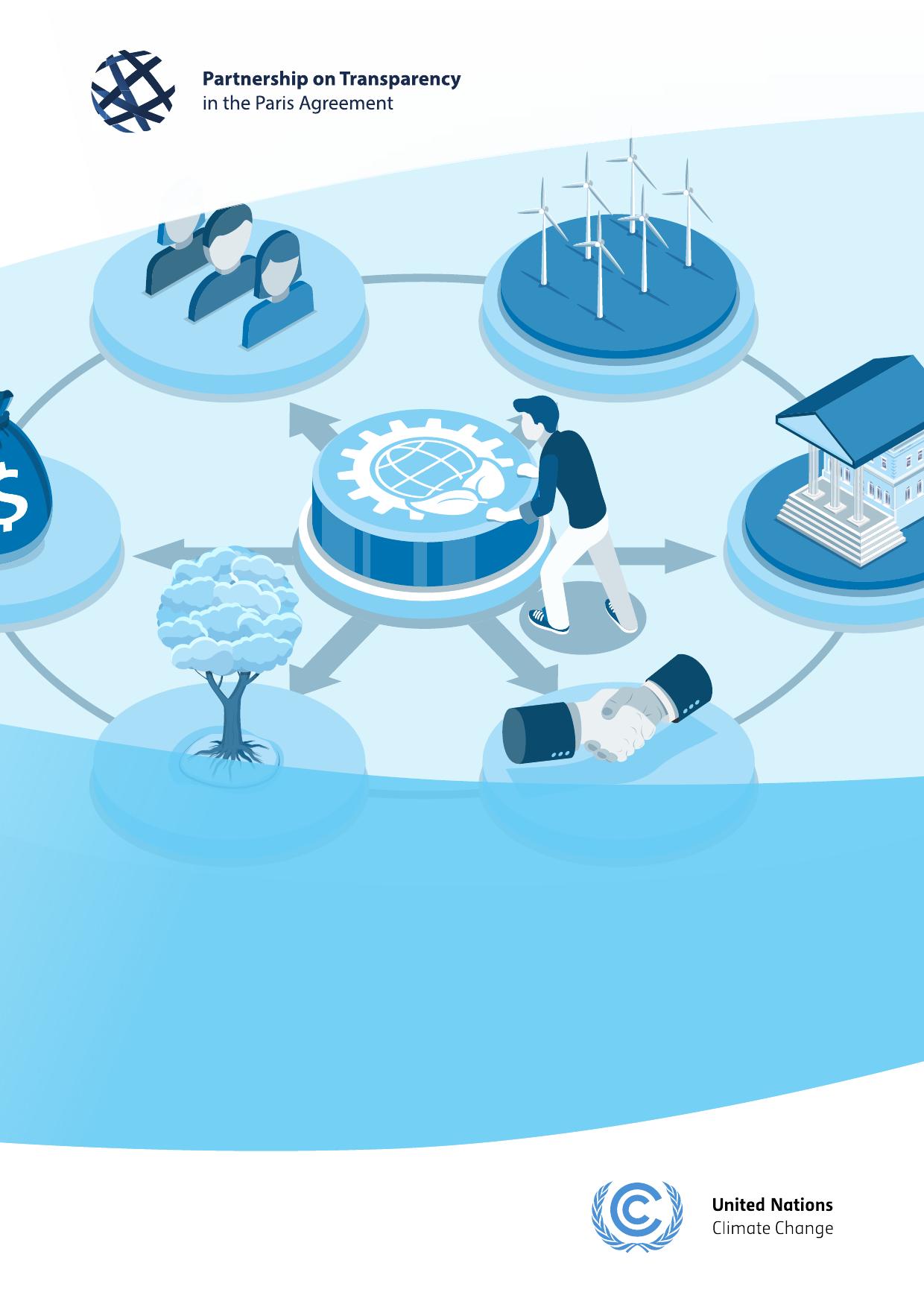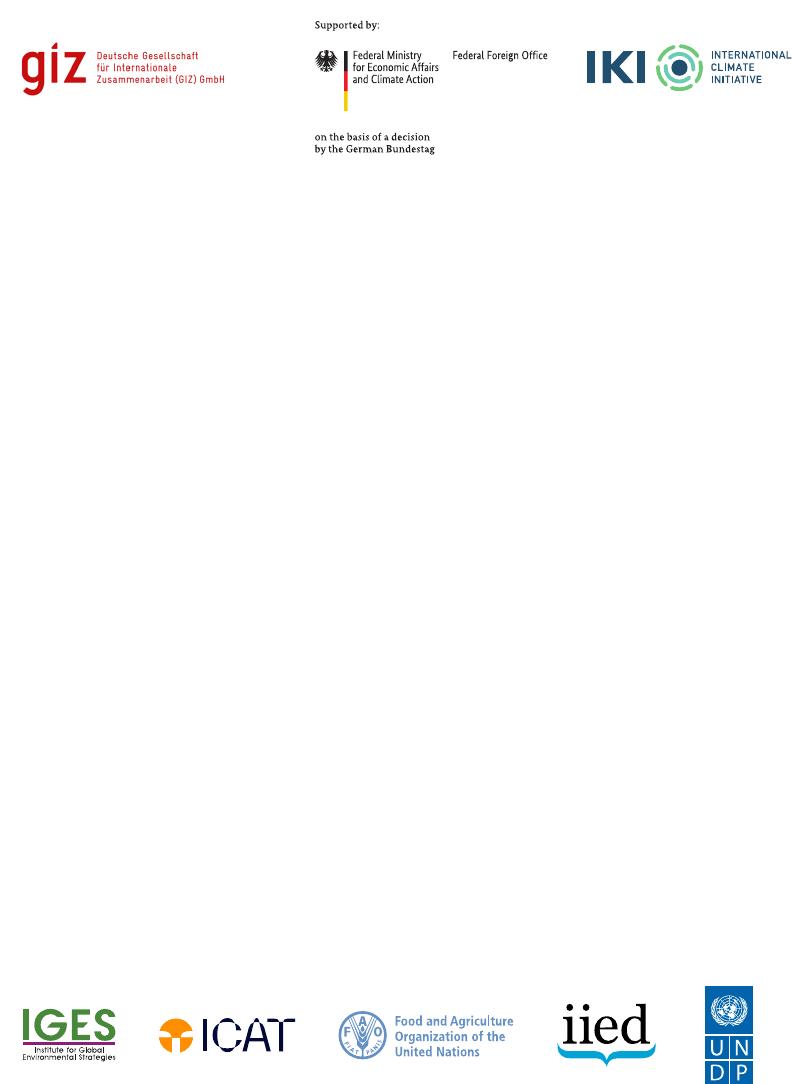TechnicalPaperBenefitsofClimateTransparencyOctober2023ImprintDisclaimerThistechnicalpaperexplorespotentialbenefitsthatcountriescangainfromimplementingclimatetransparencyarrangementsandproductsfromit,includingoperationalizinginformationsystemstotrackandreportprogressinadaptationandmitigationaction,aswellasprogressinmeansofimplementation.ItdoesnotaimtoprovideanystandardizedguidelinestothecurrentandfuturereportingrequirementsundertheUNFCCC.Thistechnicalpaperisanupdateofthe2018discussionpaper“Nationalbenefitsofclimatereporting”publishedbythePartnershiponTransparencyintheParisAgreement(PATPA).TheoriginalauthorswereAmrOsamaAbdel-Aziz,JessicaWade-Murphy,EmelieÖhlander,MortenPedersenandLuisdelaTorre,andtheoriginaleditorswereMatthiasDaun,RocioLichte,HannaReuter,VerenaSchauss,CatarinaTarpo,KlausWenzelandOscarZarzoFuertes.ThetechnicalpaperwasdevelopedbyPATPAandtheUNFCCCsecretariat,withthesupportoftheInitiativeforClimateActionTransparency(ICAT),theInstituteforGlobalEnvironmentalStrategies(IGES),theInternationalInstituteforEn-vironmentandDevelopment(IIED),theUnitedNationsDevelopmentProgramme(UNDP)andtheFoodandAgricultureOrganizationoftheUnitedNations(FAO).Theupdatetothe2018discussionpaperwaspossiblethroughtheinputsandcontributionsofthefollowingauthors,collaboratorsandeditors.AuthorsFernandaAlcobé,RichemondAssié,JasminBlessing,MoussaDiop,LorenzoEguren,CarlosEssus,OscarZarzoFuertes,HelenaHeuckmann,CarineIngabire,TemuulenMurun,MijakoNierenkoether,IllariZulemaAragonNoriega,JamesLwa-saFredrickOuma,EleniPatra,MirellaSalvatore,JulieTeng,FelipeGómezVillota,KarenVanDerWesthuizen,HenningWuester,JamesVener.ContributorsVivekAdhia,VarunAgarwal,MariaEugeniaBedoya,KaterinaCerna,GemmaNorrington-Davies,PapaLamineDiouf,NinoGogebashvili,AshwiniHingne,TugbaIcmeli,Jigme,TimothéeKagonbe,KakhaLomashvili,NouraMohamedLotfy,SamuelMabena,SandraMotshwanedi,GloriaNamande,LukasPeiler,KimSchmidt,GeorgSchmid,SvenSchuppener,AtikSheikh,AlexandraSoezer,WalaToumi,TobiasVosen,TaniaZamora.EditorsHelenPlume,Jigme.Design/LayoutundstoffersDesignbüroPhotocredits/sources©TarikVisioniStockBerlin,October20232TableofcontentsListofFigures�4ListofBoxes�5Listofabbreviationsandacronyms�61.Introduction�72.Settingthescene�83.Benefitsofclimatetransparency�113.1.Providingcoherentdataforinformeddecision-making�113.2.�Promotingcoherenceamongnationalreportinginitiatives,includingtheSustainableDevelopmentGoals�143.3.Increasingpoliticalbuy-inforclimateaction�193.4.�Enhancingandsustainingtechnicalcapacityforlong-termreportingandpolicydevelopment�223.5.Buildingknowledgeforenhancedambition�253.6.Improvingtrackingofandaccesstosupport�273.7.Enablingaccesstocarbonmarkets�293.8.�Supportingaccessiontopoliticalandeconomiccommunitiesandorganizations�323.9.Strengtheninggendermainstreaming�343.10.Raisingawarenessamongstakeholders�355.Conclusion�39TECHNICALPAPER:BENEFITSOFCLIMATETRANSPARENCYListofFiguresFigure1:�NationalbenefitsarisingfromtransparencyarrangementsundertheConventionandtheParisAgreement�7Figure2:�EnhancedtransparencyframeworkunderArticle13oftheParisAgreement�9Figure3:�MappingofSustainableDevelopmentGoalindicatorstomeasurement,reportingandverificationelements�15ListofBoxesBox1:�Tunisia:Trackingemissionsintheenergysector�12Box2:�Germany:Developinganactionplanfor2050usinginformationfromthemeasurement,reportingandverificationsystem�12Box3:�Japan:Trackingandmonitoringtheprogressofimplementationofclimatepoliciesandactionstoimprovetheireffectiveness�13Box4:�SouthAfrica:Establishingrobustinstitutionalarrangementsfordatacollectionandnationalreporting�16Box5:�Egypt:Connectingasustainabledevelopmentstrategytoaclimatemeasurement,reportingandverificationsystem�18Box6:�Senegal:Developingameasurement,reportingandverificationsystemthatcansupportthetrackingofprogressinachievingtheSustainableDevelopmentGoals�19Box7:�DominicanRepublic:Enhancingpoliticalbuy-inforclimateactionthroughcapacitydevelopmentinclimatechangereporting�20Box8:SriLanka:Strengtheningclimatetransparencyinthetransportsector�21Box9:�Cameroon:Establishinganationalmeasurement,reportingandverificationsystemaspartofimplementingthenationallydeterminedcontribution�23Box10:T�unisia:Developinganationaltransparencysystemforadaptationandmitigationactivities�24Box11:Egypt:Improvingdatacollectionrevealsopportunitiesforenhancingambition�25Box12:Uganda:Enhancingambitionandimprovingnationalpolicies�26Box13:Kenya:Developingaclimatefinancetrackingsystem�28Box14:V�anuatu:Developinganintegratedmonitoring,reportingandverificationtoolforclimateactiontracking�304TECHNICALPAPER:BENEFITSOFCLIMATETRANSPARENCYBox15:P�eru:Developingatransparencysystemthatenablesparticipationincarbonmarkets�30Box16:J�apanandSwitzerland:ImplementingpilotagreementsforcarbonmarketsunderArticle6oftheParisAgreement�31Box17:G�eorgia:Linkinganationalmeasurement,reportingandverificationsystemtoEuropeanUnionaccession�32Box18:C�olombia:ComplyingwithstatisticalinformationrequirementsforOrganisationforEconomicCo-operationandDevelopmentmembershipthroughcollaborationonmeasurement,reportingandverification�33Box19:A�ntiguaandBarbuda,CaboVerdeandtheFederatedStatesofMicronesia:Developinggender-responsivenationallydeterminedcontributionsandtransparencysystems�34Box20:I�ndia:Engagingwiththeprivatesectortounderstandthepotentialimpactsofcorporateclimateaction�35Box21:P�eru:EncouragingprivatesectorengagementthroughtheCarbonFootprintTool�36Box22:Z�imbabwe:Engagingwithnon-governmentalactorstofosteracademiaandyouthskills�37Box23:C�olombia:Quantifyingthecontributionsofsubnationalandnon-Stateactorstogreenhousegasemissionreductions�385TECHNICALPAPER:BENEFITSOFCLIMATETRANSPARENCYListofabbreviationsandacronymsBRbiennialreportBTRbiennialtransparencyreportBURbiennialupdatereportCO2carbondioxideETFenhancedtransparencyframework(undertheParisAgreement)EUEuropeanUnionFAOFoodandAgricultureOrganizationoftheUnitedNationsGHGgreenhousegasICATInitiativeforClimateActionTransparencyiMRVintegratedmonitoring,reportingandverificationIPCCIntergovernmentalPanelonClimateChangeITMOinternationallytransferredmitigationoutcomeJCMjointcreditingmechanismMELmonitoring,evaluationandlearningMPGs�modalities,proceduresandguidelinesforthetransparencyframeworkforactionandsupportreferredtoinArticle13oftheParisAgreementMRVmeasurement,reportingandverificationNAPnationaladaptationplanNCnationalcommunicationNCCRDNationalClimateChangeResponseDatabaseofSouthAfricaNDCnationallydeterminedcontributionOECDOrganisationforEconomicCo-operationandDevelopmentPATPAPartnershiponTransparencyintheParisAgreementSDGSustainableDevelopmentGoalUNFCCCUnitedNationsFrameworkConventiononClimateChangeUNDPUnitedNationsDevelopmentProgramme6TECHNICALPAPER:BENEFITSOFCLIMATETRANSPARENCY1.IntroductionThispaperaimstohighlightthebenefitsthatrobustand•Increasedawarenessofandpoliticalbuy-inforclimateself-sustainedtransparencysystemscanbringtogovern-action;ments,beyondfulfillingcurrentandfuturereportingrequirementsundertheUnitedNationsFramework•StrengthenedtechnicalcapacitiesfordevelopingandConventiononClimateChange(theConvention)andtheimplementingpolicies,plansandstrategiesforParisAgreement.Italsoaimstoreachclimatechangelow-emissionandclimate-resilientdevelopment,aswellpolicymakersandpractitionersfromdevelopingcountryasforlong-termreporting.Partiesandenhancethereader’sunderstandingofthesebenefits,whichinclude(seealsofigure1):Inaddition,thepaperprovidesexamplesfromdevelopedanddevelopingcountryPartiestoexplainandshowcase•Betterinformationforpolicydevelopmentanddeci-howincreasedeffortstoallocatehumanandfinancialsion-making;resourcesforclimatetransparencycanimprovepoliticalcommitmentandenhanceclimateambition.•Improvedaccesstocarbonmarketsandclimatefinance;Figure1:�NationalbenefitsarisingfromtransparencyarrangementsundertheConventionandtheParisAgreementTransparencyarrangementsPreparinginventoriesofTrackingprogressofAssessingtheimpactsofIdentifying,trackingandGHGemissionsandimplementingandachievingclimatechange,andreportingonsupportneededremovalstheNDC,formulating,formulating,implementingandreceivedimplementingandreportingandreportingonadaptationonmitigationpoliciesandactionsmeasuresBenefitsInformeddevelopmentofIncreasedawarenessandImprovedaccesstoclimateEnhancedcapacityfornationalpolicies,planspoliticalbuy-insupportlow-emissionandandstrategiesclimate-resilientplanningandimplementation7TECHNICALPAPER:BENEFITSOFCLIMATETRANSPARENCY2.SettingthesceneTheParisAgreement,underitsArticle2,aimstoholdtheInthisscientificandmultilateralagreementcontext,increaseintheglobalaveragetemperaturetowellbelow2nationaltransparencysystems,andtheETF,helpadvance°Cabovepre-industriallevelsandpursueeffortstolimitunderstandingintermsoftheprogress,opportunitiesandthetemperatureincreaseto1.5°Cabovepre-industrialimprovementsnecessarytosafeguardtheclimate,aswellaslevels,increasetheabilitytoadapttotheadverseimpactsofthegapsandchallengestobeovercome.TheETFisclimatechange,andmakefinanceflowsconsistentwithahelpingtobuildtheinternationaltrustandconfidencepathwaytowardslowgreenhousegas(GHG)emissionsandneededforsuccessfulimplementationoftheParisAgree-climate-resilientdevelopment.1mentandtoincreaseambition,bringingmultipleotherbenefitstonationalgovernmentsasitdoesso.PartiestotheParisAgreementcommittedtoprepare,communicateandmaintainnationallydeterminedcontri-ThefoundationsfortheETFwereinplacelongbeforethebutions(NDCs)andtostrivetocommunicatelong-termadoptionoftheParisAgreement,asitbuildsonandlow-emissiondevelopmentstrategiesunderArticle4;toenhancestheexistingmeasurement,reportingandverifica-engageinadaptationplanningprocessesunderArticle7,tion(MRV)arrangementsundertheConvention.Underwhichprovidesseveraloptionsforsubmittingandupdatingtheseexistingarrangements,thereportingrequirementsadaptationcommunications;andtoregularlyreportonandthetimelinesforthesubmissionofnationalreportsaretheirprogressundertheenhancedtransparencyframeworkdifferentfordevelopedanddevelopingcountries,in(ETF)establishedunderArticle13(seefigure2).accordancewiththeprincipleofcommonbutdifferentiat-edresponsibilitiesandrespectivecapabilities.The2022NDCSynthesisReport2statesthatassumingfullimplementationoftheNDCs,includingallconditionalThroughouttheyearsofreportingundertheConvention,elements,thebestestimateofpeakglobalmeantempera-PartieshavegainedsignificantexperienceinMRVactivi-tureinthetwenty-firstcentury(projectedmostlyfor2100ties,whichtheParisAgreementhasultimatelyrecognizedwhentemperaturecontinuestorise)isintherangeofasanimportantbasisforthedevelopmentandimplemen-2.1–2.4°C.TheSummaryforPolicymakersoftheSynthe-tationoftheETF.sisReportoftheSixthAssessmentReportoftheIntergov-ernmentalPanelonClimateChange(IPCC)identifiesthatUndertheConvention,developedcountryPartiessubmit“therearegapsbetweenprojectedemissionsfromimple-theirnationalcommunications(NCs)everyfouryearsandmentedpoliciesandthosefromNDCsandfinanceflowsbiennialreports(BRs)everytwoyears.FordevelopingfallshortofthelevelsneededtomeetclimategoalsacrosscountryParties,thefrequencyissimilar,astheyareallsectorsandregions”.3TheSummaryforPolicymakersexpectedtosubmittheirNCseveryfouryearsandtheiralsostatesthat“rapidandfar-reachingtransitionsacrossallbiennialupdatereports(BURs)everytwoyears,butthesectorsandsystemsarenecessaryto…securealiveableandlegalnaturediffers,suchasthemandatoryreportingareas.sustainablefutureforall”,highlightingthat“feasible,effective,andlow-costoptionsformitigationandadapta-tionarealreadyavailable”.41TheParisAgreementisavailableathttps://unfccc.int/process-and-meetings/the-paris-agreement.2FCCC/PA/CMA/2022/4,para.151.Availableathttps://unfccc.int/ndc-synthesis-report-2022.3ItemA.4,p.10,ofIPCC.2023.SummaryforPolicymakers.In:ClimateChange2023:SynthesisReport.ContributionofWorkingGroupsI,IIandIIItotheSixthAssessmentReportoftheIntergovernmentalPanelonClimateChange.CoreWritingTeam,HLee,andJRomero(eds.).Geneva:IPCC.Availableathttps://www.ipcc.ch/report/ar6/syr/.4ItemC.3,p.28,oftheSummaryforPolicymakersreferredtoinfootnote3above.8TECHNICALPAPER:BENEFITSOFCLIMATETRANSPARENCYUndertheETF,thetwotracksfordevelopedanddevelop-GlasgowClimatePactin20216providethetechnicalingcountriesaremerged:BRsandBURswillbesupersed-requirementsfortheoperationoftheETF,suchastheedbybiennialtransparencyreports(BTRs).Thesubmis-reportingtimeperiods,standardsandprocesses.ThesionofNCs,areportingobligationundertheConvention,evolutionofthetransparencyarrangementsunderthewillcontinue.ThefirstBTRsareduetobesubmittedatintergovernmentalclimatechangeregimecallsoncountriesthelatestby31December2024.TheETFincludesspecifictodevelopandimproveovertimetheirtransparencyflexibilitiesthatareavailabletothosedevelopingcountrysystemsandtheprocessesbywhichtheygather,analysePartiesthatneedflexibilityinthelightoftheircapacities.andreportclimateinformation.TheadvancementoftheseFurthermore,intermsofwhenBTRsaretobesubmitted,systemsallowsgovernmentstousetheknowledge,dataandinrecognitionoftheirnationalcircumstances,theleastinformationgeneratedforinformeddecision-makinganddevelopedcountriesandsmallislanddevelopingStatesmaypolicydevelopmentandcanalsohelpthemtapintothesubmittherelevantinformationattheirdiscretion.benefitsofenhancedclimatetransparency.Themodalities,proceduresandguidelines(MPGs)agreedonundertheKatowiceclimatepackagein20185andtheFigure2:�EnhancedtransparencyframeworkunderArticle13oftheParisAgreementReportingAllParties(shall)DevelopedcountryParties(shall)andotherPartiesthatprovidedsupport(should)•�Nationalgreenhousegas(GHG)inventoryreport{Article13.7(a)}Financial,technologytransferandcapacity-buildingsupportprovidedand•�ProgressmadeinimplementingandmobilizedtodevelopingcountryPartiesachievingnationallydeterminedcontribu-underArticle9,10and11{Article13.9}tion(NDC){Article13.7(b)}DevelopingcountryParties(should)AllParties(should,asappropriate)Financial,technologytransferandcapacity-•�Climatechangeimpactsandadaptationbuildingsupportneededandreceivedunder{Article13.8}Articles9,10and11{Article13.10}TechnicalAllParties(shall)DevelopedcountryParties(shall)andotherexpertreviewPartiesthatprovidedsupport(should)•�UndergotechnicalexpertreviewofinformationsubmittedunderArticles13.7Undergotechnicalexpertreviewof{Article13.11}informationsubmittedunderArticles13.9{Article13.11}FacilitativeAllParties(shall)multilateralconsiderationof•�Facilitative,multilateralconsiderationofprogresswithrespecttoeffortsunderArticle9,anditsrespectiveimplementationandachievementofitsNDC{Article13.11}progressNote:AsperArticle13,paragraphs2–3,oftheParisAgreement,anddecision18/CMA.1anditsannex,theMPGsaddresstheprovisionofflexibilitytothosedevelopingcountryPartiesthatneeditinthelightoftheircapacitiesandthespecialcircum-stancesoftheleastdevelopedcountriesandsmallislanddevelopingStates.5https://unfccc.int/process-and-meetings/the-paris-agreement/the-katowice-climate-package/katowice-climate-package.6https://unfccc.int/process-and-meetings/the-paris-agreement/the-glasgow-climate-pact-key-outcomes-from-cop26.9TECHNICALPAPER:BENEFITSOFCLIMATETRANSPARENCYDeveloping,rollingoutandmaintainingafunctionalETFarrangementsthathelpalignandscaleactionbetweenforclimatereportingcanbeacomplextask,requiringinstitutionsandreportinginitiativesandcansupporttheengagementandcooperationatmultiplelevelswithinadevelopmentofenablingpoliciesandincreasedcollectivecountry,includingbypublicandprivatesectoractors.Asambition.Inaddition,theETFandMPGsmakeitwellassupportingthenecessaryfunctionsforreportingpossibletocomparetheactionstakenbyPartiesagainstundertheConventionandtheParisAgreement,nationaltheirNDCpledgesandtargets,buildingtrustandconfi-transparencysystemscanbringadditionalbenefitstodenceamongParties.Furthermore,NCs,BRsandBURscountries.Forexample,operationalizingtheETFprovides(undertheConvention)andBTRs(undertheETF)opportunitiesforcountriestofostercollaboration,leverageprovidesubstantialinputsfortheglobalstocktakeanditspoliticalleadership,andbuildknowledgeandabetterassessmentofcollectiveprogressinachievingthegoalsofunderstandingoftheclimatechallenge.ImplementingthetheParisAgreement.7ETFalsorequirescountriestoestablishinstitutional7TheglobalstocktakeisamechanismestablishedbyArticle14oftheParisAgreementbywhichtheConferenceofthePartiesservingasthemeetingofthePartiestotheParisAgreementistoperiodicallytakestockoftheimplementationoftheAgreementandtoassessthecollectiveprogresstowardsachievingitspurposeandlong-termgoalswithaviewtosupportingPartiesinupdatingandenhancingtheiractionandsupportaswellasincreasinginternationalcooperationforclimateaction.Formoreinformation,seehttps://unfccc.int/topics/global-stocktake.10TECHNICALPAPER:BENEFITSOFCLIMATETRANSPARENCY3.BenefitsofclimatetransparencyThischapterprovidesexamplesofthebenefitsthatcancomeexamplespresentedinthischapterarerelevantformostfromoperationalizingnationaltransparencysystemstomeetParties,includingdevelopingcountries.TheexamplestherequirementsoftheETFandhighlightshowPartiesarecompriseasmallsampleofthebenefitsthatcouldbealreadymakingthemostoftheopportunitiesarisingfromgarneredfromimplementingtheETF–theremaybemanyimplementationofthetransparencyarrangements.Despitemore,dependingonnationalcircumstancesandthedifferingnationalcircumstances,theinformationandprioritiesandinstitutionalarrangementsalreadyinplace.3.1.Providingcoherentdataforinformeddecision-makingTheETFhasthreefundamentalcomponents:andtobetterunderstandthelinkagesbetweenpoliciesandemissionsoremissiontrends,orbetweenpoliciesand•Reporting;strengthenedresilienceandreducedvulnerability,allowingadjustmentsandenhancementstobemadeinsupportof•Technicalexpertreview;moreambitiousclimateaction.•Facilitative,multilateralconsiderationofprogress.TheoperationalizationoftheETFandgoodgovernance8gohandinhand.AnationaltransparencysystemcanhelpPuttingallthreecomponentsintopracticewillrequiretheimprovethereliabilityandcoherenceofdata–reliable,activeengagementofabroadsetofnationalstakeholders,coherentdataarefundamentaltoinformeddecision-mak-includingstatisticalservices,ministries,localauthorities,ingandpolicydevelopmentacrosssectors.Moreover,privateorganizationsandcivilsociety,asappropriate.coherentdatacanimprovetheconsistencyofprojectionsDependingonnationalcircumstances,theinstitutionaland‘businessasusual’scenarios,aswellasenhanceeffortsarrangementsputinplacefortransparencypurposesundertoimplementactionreflectedinthecountry’sNDC.theConventionandtheParisAgreementcanprovideopportunitiesforsubnationalentitiesandotherstakehold-TheexamplefromTunisiainbox1showshowanewerstobecomeinvolvedinprovidinginformationoremissiontrackingtoolhelpedimprovedatacollection,compiling,analysingorinterpretingtheinformationdevelopprojectionsfortheenergysectorandsupportgathered.Collaborativearrangementscanalsohelpnationalpolicymaking.Inbox2,theexamplefromstatisticalservicesandotherorganizationsensuretheGermanyshowshowdatageneratedforreportingunderreliabilityofthedataandtheircoherenceacrossmultipletheConventioncanbeusedforlong-termclimatepolicyreportinginitiatives.development.Box3explainshowJapanisassessingtheprogressofimplementationofitsclimatepoliciesandTheinformationgatheredforinternationalreportingactionstoimprovetheireffectiveness.purposesisalsoimportantatthedomesticlevel,providingcountrieswithanessentialinputtopolicydevelopmentrelatedtoemissionreductionandclimateresilience.Thisinformationalsoprovidesthebasisforcountriestoanalysetheefficiencyandeffectivenessofpolicyimplementation8Goodgovernancehaseightmajorcharacteristics:itisparticipatory,consensus-oriented,accountable,transparent,responsive,effectiveandefficient,andequitableandinclusive,anditfollowstheruleoflaw.Itensuresthatcorruptionisminimized,theviewsofminoritiesaretakenintoaccountandthevoicesofthemostvulnerableinsocietyareheardindecision-making.Itisalsoresponsivetothepresentandfutureneedsofsociety.Seehttps://www.unescap.org/sites/default/files/good-governance.pdf11TECHNICALPAPER:BENEFITSOFCLIMATETRANSPARENCYBox1:Tunisia:TrackingemissionsintheenergysectorIn2022,TunisiadevelopedapowerfultoolfortrackingChangesinGHGemissionsareattributedtokeyglobalcarbondioxide(CO2)emissionsfromtheenergyandsectoraldrivers,generatingsubstantiveinformationsectorthatenablestheNationalAgencyforEnergyfordecision-makingandpolicydevelopment.AManagementtomonitorprogresstowardsachievingdetailed,transparentanalysisofpasttrendsfacilitatesthethecountry’smitigationobjectives.9Theapproachforconstructionofforward-lookingscenariosandprovidestrackingemissionsconsiderstheMPGsfortheETFinformationtoguideupdatestotheNDC.aswellasthe2006IPCCGuidelinesforNationalGreenhouseGasInventories.ThemethodusesglobalThetoolwasdevelopedbytheTunisianNationalinformationandanationalenergyinformationsystemAgencyforEnergyManagementthroughtheprojectdataset.ItquantifiestheeffectsofdriversofGHGtitled“SettingupinstitutionalcapacitiesforNDCemissionsintheenergysectorandthenanalysestheirimplementationinTunisia”,whichwasfinancedbytheimpactsintermsofGHGemissionsoveragivenperiod.InternationalClimateInitiativeoftheGermanFederalMinistryforEconomicAffairsandClimateAction.9Formoreinformation,seehttps://www.international-climate-initiative.com/en/project/setting-up-the-institutional-capacities-for-the-implementation-of-tunisias-ndcs-20-i-316-tun-g-ndc/.Box2:Germany:Developinganactionplanfor2050usinginformationfromthemeasurement,reportingandverificationsystemIn2016,Germanyadopteditslong-termstrategywillalsoharmonizedatarecordsforthewholecountry,forclimateaction,theClimateActionPlan2050.10makingthemavailableelectronicallytofacilitateThedocumentwasupdatedin202211inresponseaccess.AnnualclimateactionreportspreparedbythetorecentpolicyandregulatorydevelopmentsintheGovernmentshowprogressinimplementingmeasures,country,includingtheapprovaloftheClimateChangepresentcurrentemissiontrendsandestimatetheAct,12whichsetsoutmandatoryemissionreductionexpectedemissionreductions.Thesereportswillbeusedtargets,monitoringschemesandamechanismforfordevelopingmoreambitiousclimatemeasures.constantimprovement.TheClimateActionPlan2050summarizestheGermanGovernment’sclimateTheClimateChangeActsetsannualemissionreductionprotectionpolicyandthegovernancesystemfortargetsfordifferentsectors.Toreview,onanannualcompliancewithclimatetargetsanddescribesthebasis,thecomplianceofthesesectorswiththetargetspathwaytoaGHG-neutralGermanyby2045,withthereisaclearlinkbetweentheemissiondatareportedanegativeGHGbalanceafter2050.Theupdatedinternationallyanddomesticpolicyresponse.ThedocumentsetsoutambitiousGHGemissionreductionGermanEnvironmentAgencypublishesemissiontargetslinkedtonationalandsubnationalMRVsystemsdataestimatesfortheprecedingyear,consideringthethataddtransparencytoimplementationeffortsaimednationalGHGinventory.WhenannualemissionsatensuringtheachievementofGermany’smedium-andexceedtheirtargetforagivensector,thefederalministrylong-termclimatetargets.TheGermanGovernmentresponsibleforthatsectormustdevelopanimmediate10Availableathttps://www.bmuv.de/en/publication/climate-action-plan-2050-en.11Availableathttps://unfccc.int/process/the-paris-agreement/long-term-strategies12ForinformationabouttheClimateChangeAct,seehttps://www.bundesregierung.de/breg-de/themen/klimaschutz/climate-change-act-2021-1936846.12TECHNICALPAPER:BENEFITSOFCLIMATETRANSPARENCYactionplantoensurecompliancewiththetargetintheActionandtheFederalMinistryofLabourandSocialcomingyears.TheClimateActionPlan2050functionsAffairswillestablishaclimateactionsocialmonitoringasacontinuouslearningprocess,witharegularrevisionsystemthatcomplementsthecountry’stransparencyoftargetsandsteadyimprovementaspertheParisframeworktoevaluatethesocialacceptanceofclimateAgreement.policiesandinstruments.ThismonitoringsystemwillassistpolicymakersinimprovingpolicyinstrumentsforFurthermore,tohelpshapeasociallyjusttransition,ajusttransition.theFederalMinistryforEconomicAffairsandClimateBox3:Japan:TrackingandmonitoringtheprogressofimplementationofclimatepoliciesandactionstoimprovetheireffectivenessJapanhasanambitioustargettoachievenetzeroGHGemissionstoachievetheNDCtargetby2030.GHGemissionsby2050.Furthermore,itsNDCToregularlytrackimplementationandensurethetargetisa46percentreductioninGHGemissionsbyeffectivenessofthePlan,theJapaneseGovernment2030comparedwiththebase-year(2013)level.ThestrictlyevaluatestheprogressofclimatepoliciesandkeylegislationforachievingthesetargetsistheActactionseachyear,disclosesinformationpublicly,andonPromotionofGlobalWarmingCountermeasuresreviseslow-performingpoliciesandactions.Evaluation(1998),whichwasamendedafterJapandeclaredinoftheimplementationofpoliciesandactionsis2021itscommitmenttonetzero.JapanenhanceditsachievedbycomparingforecastedannualtargetsagainstPlanforGlobalWarmingCountermeasures,bysettingthemeasuredindicators.13non-bindingtargetsateachsectorforreducingEvaluationresultsoftheimplementationofmitigationpoliciesandmeasuresin2020CategoryExplanationNumberofpoliciesandmeasuresA6PoliciesandmeasuresforwhichtheevaluationindicatorisexpectedtoBexceedthetargetlevelifcurrenteffortscontinueandforwhichthe15Cactualresultshavealreadyexceededthetargetlevel66D21EPoliciesandmeasuresforwhichtheevaluationindicatorisexpectedto7exceedthetargetlevelifcurrenteffortscontinue(excludingA)PoliciesandmeasuresforwhichtheevaluationindicatorisexpectedtobeequivalenttothetargetlevelifcurrenteffortscontinuePoliciesandmeasuresforwhichtheevaluationindicatorisexpectedtofallbelowthetargetlevelifcurrenteffortscontinuePoliciesandmeasuresforwhichquantitativedatacannotbeobtainedThetableabovepresentsthefivecategoriesunderwhichyears.Thedataandinformationgeneratedfromthispoliciesandactionsarerankedfollowingevaluationdomesticmonitoringandevaluationsystemhelpstheoftheprogressoftheirimplementation.PoliciesandGovernmenttoimproveclimatepoliciesandactionsactionsassessedasbeingintheCandDcategoriesandtoenhanceNDCimplementationinthecountry.willbeenhancedandreinforcedoverthenextfew13Japan’s2021PlanforGlobalWarmingCountermeasuresisavailable(inJapanese)athttps://www.env.go.jp/content/900440195.pdfandthe2022progressreportonthePlanisavailable(inJapanese)athttps://www.kantei.go.jp/jp/singi/ondanka/kaisai/dai49/pdf/siryou1.pdf.13TECHNICALPAPER:BENEFITSOFCLIMATETRANSPARENCY3.2Promotingcoherenceamongnationalreportinginitiatives,includingtheSustainableDevelopmentGoalsNationalgovernmentshavereportingrequirementsunderpollutantsareoftenemittedfromthesamesources,sothevariousinternationalconventionsandagreementstheymultipleinventorysystemscancombinedatacollectionhavesignedorratified.PartiestotheConventionmustandprocessingandsupportthedevelopmentofpoliciesreportonmeasurestheyundertaketomitigateandadapttoandmitigationmeasuresthattargetGHGandotherairclimatechange.Developingcountriesarerequired,underpollutantsatthesametime.OtheropportunitiesthatcantheConvention,toperiodicallyreportontheirnationalbeseizedwhendevelopingMRVandMELsystemsrelatecircumstances,GHGemissions,mitigationandadaptationtosharedinstitutionalarrangementsandcollaborationonactions,andthecapacity-building,technologyandclimatereporting.financialsupporttheyneedtotackletheclimatecrisis.Similarly,MemberStatesoftheUnitedNationsreportonMELsystemsareakeycomponentoftransparencyinthetheirprogresstowardsachievingthe17SustainablenationaladaptationplanningprocessbecausesuchsystemsDevelopmentGoals(SDGs)andthe169targetsoftheenablecountriestobetterunderstandwhichadaptation2030AgendaforSustainableDevelopment,andPartiestoactionsareworkingandwhoisbenefitinginwhatways.theConventiononBiologicalDiversityreportonthestatusWell-designedMELsystemsenablecountriestomakeandtrendsofbiodiversityandtheireffortsregardingitsdecisionsmoretransparentlyandensurethatthemostconservationandsustainableuse.Countriesmayhavevulnerablepeopleandcommunitiesbenefitfromtheadditionalreportingrequirementsonwaterquality,airprocessesofdeveloping,implementingandupdatingquality,landuse,wastemanagement,humanrights,andnationaladaptationplans(NAPs).Giventheneedforeconomicandfinancialperformance,amongothers.alignmentbetweenNAPsandtheadaptationcomponentsofNDCs,BTRsandNCs,thecountriesthatalreadyhaveComplyingwithallinternationalreportingrequirementseffectiveMELsystemsestablishedundertheNAParewellefficientlyisacomplextask.However,thereareopportuni-placedtoreporteffectivelyandefficientlyontheiractionstiesforbetterconnectingexistingMRV,monitoring,thatrelatetoadaptation.evaluationandlearning(MEL),andinformationsystemsandsimplifyingreportingprocessesthatcanbringaddi-tionalbenefitstogovernments–andtoclimateaction.Onesuchopportunityliesinthedevelopmentofanintegratedreportingsystemthatcanbringcoherencetoandfostersynergiesacrossdifferentreportingsystems.Integratingsystemsispossiblebecauseoftheinherentlinkagesbetweenbiodiversityprotection,climateactionandhumandevelopment,andthecloseinterconnectionbetweenthegoalsandtargetsofdifferentinternationalconventions.Forexample,the2030AgendaforSustainableDevelopmentandtheobjectiveoftheConventionhaveclearlinkagesaroundSDG7onaffordableandcleanenergy,SDG11onsustainablecitiesandcommunitiesandSDG13onclimateaction(seefigure3).Settingupasystemthatcombinesinformationonemis-sionsofGHGsandotherairpollutantscanhelpcountriesidentifymeasureswithdiversebenefitsandreducetheduplicationofreportingstructures.GHGsandotherair14TFEiCgHNuIrCAeL3PA:PE�MR:aBEpNpEFiInTSgOFoCfLIMSAuTEsTtRaAiNnSPaAbRElNeCYDevelopmentGoalindicatorstomeasurement,reportingandverificationelements14SDGindicatorsMRVelementsGoal1NoPoverty1.5.1/11.5.1/13.1.1NationalcircumstancesDevelopmentpriorities,objectivesand1.5.2circumstancesInstitutionalarrangements1.5.3/11.b.1/13.1.2NationalGHGInventory1.5.4/11.b.2/13.1.3EnergyIPPUGoal2ZeroHunger2.4.1AFOLUWaste2.5.2Adaptationrelated:Measurestofacilitate2.a.1adequateadaptationtoclimatechangeGoal6C�leanWater&6.3.1Vulnerability,Baselineconditions,V&AmethodsandtoolsSanitation6.5.1AdaptationstrategiesandmeasuresKeyfindingsandintegratingeffectsGoal7A�ffordable&7.1.2InstitutionalarrangementsCleanEnergy7.2.1Mitigationrelated:Measurestomitigateclimatechange7.3.1Mitigationassessment7.a.1MitigationactionsDomesticMRVGoal8D�ecentWork&8.4.1/12.2.1EconomicGrowth8.4.2StepstakentointegrateclimatechangeTechnologytransferGoal9�I�ndustry,9.1.2ResearchandsystematicobservationEducation,trainingandpublicawarenessInnovation&9.2.1Capacity-buildingNetworkingInfrastructureConstraintsandgaps,andrelatedFTCneedsand9.4.1supportreceivedandneeded9.a.1Financial,technicalandcapacityneedsProposedprojectsforfinancingGoal11�S�ustainable11.2.1ImplementationofadaptationmeasuresCities&11.5.2Othercapacity-buildingneedsCommunities11.6.1EnhancingnationalcapacityfordatacollectionGoal12�R�esponsible12.3.1andmonitoringConsumption&12.4.2Production12.5.1Informationcanfeedintobothmonitoringframeworks(mutualbenefit)12.8.1Informationforoneframeworkcaninformtheotherframework(co-benefit)12.c.1Informationforoneframeworkcouldberelevanttotheother(potentialbenefit)Goal13�C�limateAction13.2.1Informationcouldberelevant,dependingonmetadatatobedetermined(TBD)13.3.113.3.213.a.113.b.1Goal15�L�ifeonLand15.1.115.2.115.3.115.4.2Goal17�P�artnerships17.2.1fortheGoals17.6.117.9.117.18.117.18.217.18.317.19.114Formoreinformation,seeExploringsynergiesbetweenmeasurement,reportingandverificationundertheConventionandthemonitoringoftheimplementationoftheSustainableDevelopmentGoals,UNFCCC,2017.15TECHNICALPAPER:BENEFITSOFCLIMATETRANSPARENCYTheconnectionbetweeninternationalreportingon13and15(lifeonland))andclimatecommitments.progressundertheParisAgreementthroughtheETFandLinkingtheindicatorsusedunderdifferentconventionsnationalclimateandotherreportingmeansthatgovern-andagreementscanalsoimprovethecomplementarity,mentscanfacilitatecooperationbetweeninstitutionstoreliabilityandcoherenceoftheinformationreported.streamlineandstandardizecomplementaryprocessestoimprovedata-sharingandconsistency.ThesecanbeAdaptationcanplayasignificantroleinachievingtheachievedby:SDGsbecausemanyofthesectorsthataremostvulnerabletoclimatechangearekeytocountries’development,such•Adoptingcommondatastandardsandprotocolsorasagriculture,health,water,infrastructureandurbanareas.commonreportingplatformsanddatabases;Forinstance,promotingsustainableagricultureandaddressingclimatechangeintheagriculturesectoryields•Enhancingdatacomparabilityandconsistency;significantbenefitswithregardtofoodsecurityandthereforetoSDG2(onzerohunger),whileadaptation•Ensuringthattheinformationcollectedisusedtomeasuresthatpreventorreducetheimpactoffloodingininformdecision-makingandpolicydevelopment.urbanareascancontributetoachievingSDG11.Inaddition,MRVsystemsmaycollectdataandinforma-ThecountrycasespresentedinthissectionfromSouthtionthatfacilitatesthemonitoringofthesocial,economicAfrica(box4),Egypt(box5)andSenegal(box6)showandenvironmentaldimensionsofsustainabledevelopment.hownationalgovernmentshavedevelopedsynergiesacrossAssuch,MRVandMELsystemscanprovidedataandseparatereportinginitiatives,resultinginincreasedinformationfortrackingprogressinachievingSDGs.Thiscollaboration,accountability,awarenessandpoliticalisparticularlythecaseifaspecifictrackingsystemisnotorbuy-in,withstrongerMRVandinformationsystemsandisonlypartiallyinplace,butcanmakeuseofexistingenhancedtransparency.structuresforsimultaneouslytrackingSDGs(e.g.SDGs7,Box4:SouthAfrica:EstablishingrobustinstitutionalarrangementsfordatacollectionandnationalreportingSouthAfrica’sclimatechangeMRVsystemisinformedTheNCCRD,coordinatedbytheDepartmentofbytheNationalClimateChangeResponsePolicyForestry,FisheriesandtheEnvironment,collects(2011),forwhichasystemwasestablishedtomonitorinformationfromvoluntarilyregisteredadaptationandthecountry’stransitiontoalowercarboneconomymitigationprojects.Thedatabaserecordsinformationandaclimate-resilientsociety.Operationalsince2009,abouttheseprojectssuchastheirlocation,description,SouthAfrica’sNationalClimateChangeResponseassociatedimpacts,fundingsources,supportersandDatabase(NCCRD)isanonlineplatformthatallowsrelatedactivities.userstotracknational-,provincial-andlocal-levelactionstocombatclimatechange.15TheNCCRDispartoftheNationalClimateChangeInformationSystem,whichalsoincorporatestheClimateInformationPortal,ahazardouseventsdatabase,atrackingandevaluationsystem,andanairqualityinformationsystem16(seethefigurebelow).15Thedatabaseisavailableathttps://nccrd.environment.gov.za/.16Forfurtherinformation,seeSouthAfrica’sfourthBUR,availableathttps://unfccc.int/documents/307104.16TECHNICALPAPER:BENEFITSOFCLIMATETRANSPARENCYSouthAfrica’sNationalClimateChangeInformationSystem17NationalClimateChangeInformationSystemManagedbyDepartmentofForestry,FisheriesandtheEnvironmentSouthAfricanAirQualityClimateInformationPortalNationalInformationSvstemInventoryReportNationalHazardousEventsSouthAfricanGHGDatabaseNationalEmissionRegulationCommunicationsandBiennialUpdateReportingSystemReportsUNFCCCTrackingandEvaluationNationalClimateChangeSystemResponseDatabaseProvincesandDataprovidersMunicipalitiesIndustrySouthAfricanWeatherServiceOtherTheNationalClimateChangeInformationSystemandSouthAfrica’sMRVsystemalsoinformsdomesticitsNCCRDservethereportingrequirementsunderthereportingonclimateactionthroughannualclimateConventionandallowtheSouthAfricanGovernmentto:changereports,18inwhichinformationonclimateactions,includingtheirimpactsandtheircontribution•Developaninformedpositionforinternationaltothenationaldevelopmentplanimperativesofclimatechangenegotiations;reducingpovertyandaddressinginequalityandjobcreation,iscompiled.EventhoughtheNCCRDwas•Avoidduplicatingmitigation,adaptationandoriginallydevelopedtomeetthereportingrequirementsresearchprojects;undertheConvention,itsinformationcontentandannualreportshavethepotentialtocatalyseadditional•Identifygaps,needsandopportunitiesinclimateandmoreambitiousclimateactionsandfundingandtoaction;providecomplementaryinformationforothernationalpurposesandinternationalreportinginitiatives,suchas•TrackambitionandtheimpactofclimateresponsesthoserelatedtotheSDGs.inthecountry;•Identifyprojectstoscaleupforenhancedclimateambition.17AdaptedfromSouthAfrica’sfourthBUR,figure6.2,pp.219–220.Availableathttps://unfccc.int/documents/307104.18Availableathttps://cer.org.za/virtual-library/gvt_docs/south-africas-annual-climate-change-reports.17TECHNICALPAPER:BENEFITSOFCLIMATETRANSPARENCYBox5:Egypt:Connectingasustainabledevelopmentstrategytoaclimatemeasurement,reportingandverificationsystemTheGovernmentofEgyptestablisheditssustainableEachpillarincludesthreetypesofindicators:inputdevelopmentstrategy,EgyptVision2030,19usingaindicatorstomeasuretheresourcesavailable,outcomeparticipatorystrategicplanningapproach.Variousindicatorstomeasureresults,andstrategicresultscivilsocietyorganizations,nationalandinternationalindicators.developmentpartnersandgovernmentinstitutionscollaboratedonsettingcomprehensiveobjectivesforTheenergypillarincludesmitigationtargetsofathestrategy.EgyptaimstobecomeacountrywithreductioninGHGemissionsfromtheenergysectorofacompetitive,balancedanddiversifiedeconomy,5percentby2020and10percentby2030compareddependentoninnovationandknowledge,basedonwiththe‘businessasusual’scenario.Therearesynergiesjustice,socialintegrityandparticipation,characterizedinmonitoringprogressusingenergysectorindicators,byabalancedanddiversifiedecologicalcollaborationmeasuringtheemissionreductionsfromclimateactionssystem,investingtheingenuityofplaceandhumansimplementedintheenergysectorandEgypt’sMRVtoachievesustainabledevelopmentandtoimprovesystem,whichcomplieswithUNFCCCreportingEgyptians’qualityoflife.requirements.ThesustainabledevelopmentstrategycoversthethreeTheenvironmentaldimensionhasanenvironmentdimensionsofsustainabledevelopmentsetoutinthepillarandanurbandevelopmentpillar.Underthecountry’s2030agenda–namelysocial,environmentalenvironmentpillar,environmentalconsiderationsandeconomic–witheachdimensionstructuredaroundareintegratedintoalleconomicsectorswiththeaimanumberofpillars.Theeconomicdimensionhasfourofpreservingnaturalresourcesandsupportingtheirpillars:efficientuseandinvestmentwhileprotectingtherightsoffuturegenerations.Undertheenvironmentpillar,(1)Economicdevelopment;theindicatorontherateofreductionoftheexpectedincreasingratesofgreenhousegasemissionsisindicated(2)Energy(efficientuseofresources);avalueof276tCO2equivalent.Therefore,monitoringtheindicatorsofEgypt’sVision2030willbelinkedwith(3)Knowledge,innovationandscientificresearch;climatereporting,takingadvantageofsynergiesindatacollectionandanalysisbetweenthesereportingsystems.(4)Transparencyandefficientgovernmentinstitutions.19Availableathttps://arabdevelopmentportal.com/sites/default/files/publication/sds_egypt_vision_2030.pdf.18TECHNICALPAPER:BENEFITSOFCLIMATETRANSPARENCYBox6:Senegal:Developingameasurement,reportingandverificationsystemthatcansupportthetrackingofprogressinachievingtheSustainableDevelopmentGoalsSenegalisintheprocessofformalizingitsMRVDespitelackingcapacity,resourcestofinancesystem.Thecountryhasestablishedinstitutionalmonitoringandanonlineplatformthroughwhicharrangementsandqualitycontrolprocessesforenergydatacanbeaccessed,21theGovernmentofproducingitsGHGinventories,NCsandBURsthatSenegalhasasolidfoundationfordevelopingaalsomakeitpossibletousethecollectedinformationforrobustMRVsystemfortheenergysectorthroughitssustainabledevelopmentreporting.TheMinistryofthemechanismfordatacollectionanditsframeworkforEnvironmentandSustainableDevelopment,supportedvalidationofthedata.Inthiscontext,theframeworkbyinternationaltechnicalpartners,isestablishingforclimatereportingthatisbeingdevelopedhasthesectoralMRVsystemsandinstitutionalframeworksforpotentialtoprovidetheaddedbenefitofsupportingtheenergy,waste,transport,industrialprocessesandthetrackingofprogresstowardsachievingSDG7byagriculturesectors.producinginformationaboutcleanenergygenerationandruralelectrification.IndevelopingarobustMRVsystem,theenergysectorisparticularlyrelevantforSenegal,givenitsimportanceAnotherexampleofpotentialsynergiesbetweenfortheeconomictransformationofthecountry(seeinternationalreportingrequirementsisSenegal’sthePlanforanEmergingSenegal20),itshighemissions,proposedmonitoringsystemfortrackingadaptationandandSenegal’spreviousreportingexperienceforthisvulnerability,whichcanalsotakestockofprogressinsector.InitsNDC,SenegalcommittedtouniversalachievingvariousSDGs.Inaddition,Senegal’sclimateaccesstoelectricityinruralareasby2025andinstallingfinancemonitoringsystemwillfollowprivatesectorapproximately700MWcapacityfromrenewableengagementinclimateactionandprovideinformationenergygenerationtechnologiesby2030.ThesetargetsrelevanttoredirectingresourcestowardsachievingthecloselylinktheNDCwithSDG7(affordableandcleanSDGs.energy).20Seehttps://www.presidence.sn/en/pse/emerging-senegal.21Seethefinalreport,available(inFrench)athttps://climateactiontransparency.org/wp-content/uploads/2021/09/D1-Rapport-general-de-letude-sur-la-mise-en-place-dun-systeme-de-mesure-notification-et-de-verification-MNV-de-la-contribution-determinee-au-niveau-national-CDN-du-Senegal.pdf.3.3Increasingpoliticalbuy-inforclimateactionTheurgentneedforimplementingNDCstoachievethewith2°Candresolvedtopursuefurthereffortstolimitthelong-termgoalsoftheParisAgreementrequirespoliticaltemperatureincreaseto1.5°C.22However,the2022NDCleadershipandcommitmenttobemet.TheConferenceofSynthesisReportstatesthatevenunderthescenariooffullthePartiesservingasthemeetingofthePartiestotheParisimplementationofthe166latestavailableNDCsfrom193Agreement,atitsfourthsessionheldinSharmel-SheikhinPartiestotheParisAgreement,thebestestimateforpeak2022,reiteratedthattheimpactsofclimatechangewillbeglobalmeantemperatureincreaseis2.1–2.4°Cbytheendmuchloweratatemperatureincreaseof1.5°Ccomparedofthecentury.2322Decision1/CMA.4,para.8.Availableathttps://unfccc.int/sites/default/files/resource/cma2022_10_a01E.pdf.23FCCC/PA/CMA/2022/4.Availableathttps://unfccc.int/documents/619180.19TECHNICALPAPER:BENEFITSOFCLIMATETRANSPARENCYThishighlightstheurgencyforimplementingscaled-uppolicymakersanddecisionmakers,therebyacceleratingNDCs.Scalingupactiondependsonthebuy-inandclimateaction.Afunctioningtransparencysystemcanalsosustainedsupportofpoliticalleadersatthehighestlevels,provideadeeperunderstandingofthecauses,gapsandandtherollingoutandtrackingofsectoralpoliciesthatchallenges,aswellaspossiblesolutions,which,ifaddressed,enablethenecessarytransformations.couldaccelerateclimateactionandincreasetheengage-mentofpoliticalleaders.Furthermore,buy-infromOverrecentyears,publicawarenessofthethreatsofclimatepolicymakerscanbeenhancedbyprovidingadditionalchangehasincreasedasgovernments,communitiesandinformationfromtransparencysystemsontheco-benefitsindustriesfeeltheincreasingimpactsofextremeweatherofclimateactionforjobcreation,pollutionreductionandevents.Asaresult,civilsocietyandpractitionersalikearebiodiversityprotection.Developingcapacities,institution-stronglyencouragingpolicymakerstotackleclimatechangealizingprocessesandraisingawarenessrelatingtolow-emis-andimplementpoliciestoreduceGHGemissionsandsiondevelopmentandclimateresiliencecanalsofosterincreaseresilience.Havingtransparentandreliablepoliticalsupport.informationgroundedinsciencehelpssupportsdeci-sion-makingandencouragescommitmentfrompoliticians,Thetwocasespresentedbelow,onefromtheDominicanenablingthedevelopmentofalong-termvision.Republic(box7)andtheotherfromSriLanka(box8),aregoodexamplesofhowdevelopingcountrieshavemanagedTransparencyprocessescanenhancecollaborationbetweentoenhancepoliticalbuy-inforclimateactionthroughgovernmentinstitutionsandprovideopenaccesstoclimatereporting.informationthatraisestheawarenessandaccountabilityofBox7:DominicanRepublic:Enhancingpoliticalbuy-inforclimateactionthroughcapacitydevelopmentinclimatechangereportingTheDominicanRepublichadanearlystartinforinternationalreportingledtoanunderstandingofprioritizingclimatechangeinthenationalpoliticalclimatechangedrivers,impactsandvulnerabilities,and,agenda.Intheearly2010s,thecountryestablishedinturn,improvedbuy-inamongpoliticalleaders.theNationalCouncilforClimateChangeandCleanDevelopmentMechanismonthebasisofapresidentialNationalclimatechangepolicyoccupiesaprominentdecreefrom2008andalsodevelopedanationalstrategyplaceonthepublicagenda,acontributingfactorofforlow-carbondevelopment.However,nationalwhichisthattheDominicanRepublicisoneofthecapacitiesforconductingvulnerabilityassessmentsandcountrieswiththehighestclimaticvulnerabilityowingestimatingGHGemissionsremainedlowformanytoitbeinganislandanditsgeographicallocation.years,whichmeantthatonlyafewclimatepolicieswereimplemented.TheDominicanRepublic’sclimateagendahasgainedrelevanceinrecentyears.TheclimatechangeworkingIn2014,whentheDominicanRepublicbegangrouphascontributedtodevelopingtheNDC,inpreparingitsNC3,itdecidedtodevelopthesenationalwhichthecountrycommitstoreducingGHGemissionscapacitiesandestablishedaclimatechangeworkingby27percent(20percentconditionaltarget,7pergroupcomprisingexpertsfromdifferentministriescentunconditionaltarget)by2030comparedwiththeandagencies.Internationalconsultantshadalreadybaseline.TheNationalCouncilforClimateChangeandpreparedGHGestimates,sotheworkinggroupneededCleanDevelopmentMechanismhasalsobeenworkingtodevelopcapacitiesforpreparingthecountry’sonaproposedclimatechangelawwiththesupportofnationalGHGinventoryreportandthevulnerabilityothernationalinstitutions,whichillustratesthebenefitassessmentforinclusionintheNC3.Increasingtheofagoodinformationbaseleadingtopoliticalbuy-incapacityfordevelopingtheinformationbaserequiredfordevelopingamoreclimate-resilienteconomy.In20TECHNICALPAPER:BENEFITSOFCLIMATETRANSPARENCY2020,theParliamentoftheDominicanRepublicpassedrolesandresponsibilitiesofthekeyentitiesinvolveddecree541-20,whichestablishedalegalframeworkforincollecting,compilingandreportingdataandanationaltransparencysystemanddefinedthemaininformation.2424Forfurtherinformation,seehttps://climateactiontransparency.org/case-study-improving-the-mrv-framework-and-ndc-tracking-in-dominican-republic.Box8:SriLanka:Strengtheningclimatetransparencyinthetransportsector25Withthedesiretodeliveronitsclimatechangerevisedactionsandindicatorsforthetransportsector,reportingcommitments,SriLankamadeeffortsandvalidateinstitutionalresponsibilitiesintheMRVtodevelopthecountry’sfirstMRVsystem,foritssystem.transportsector.Theprocesswaskeytohelpingthenationalgovernmentreviewmanyofitsclimate-TheseeffortsenabledSriLankatoreviewtheeffectsofrelatedcommitmentsandwillsupportthecountrytransportpoliciesontheelectricandhybridvehiclesindevelopingclimatechangeprojectsandenhancingsubsectorintermsofGHGemissions.Inturn,doingsosustainabledevelopment.helpedthegovernmenttoreviewandreviseseveralofitstransportsectorpoliciesandmeasures,asreflectedinitsSriLankapartneredwiththeInitiativeforClimateupdatedNDC.ActionTransparency(ICAT)in2018todesignthenationalMRVsystemforthetransportsectorandreviseRaisingawarenessandimprovingcommunicationtransport-relatedNDCactions.Withnohistoricalamongnationalandsubnationalstakeholdershastransportdatasetsavailable,collectingtherequireddataresultedintheirgaininganunderstandingoftheMRVfromseveralministriesandagencieswasthenecessarysystemandthebenefitsoftransparencyinreportingstartingpointinthedevelopmentofthesystem.TheonclimateactionandonprogressinachievingGHGMinistryofEnvironmentaswellastheMinistryofemissionreductiontargetsintheNDC.EnhancedTransportinitiatedareviewofdataavailableandtransparencyisexpectedtosupportSriLankaninstitutionalarrangementsinplaceinthetransportpolicymakersindevelopingandapprovingnewandsector.Extensiveconsultationswithstakeholders,updatednationaldevelopmentplansandclimatechangeincludingallrelevantministriesandinstitutions,projectswhoseimplementationissustainable.EnablingcontributedtothedesignofthecentralizedMRVsystem.localownershipoftheprojecttodeveloptheMRVRolesandresponsibilitieswereassigned,andaroadmapsystemhashelpedtostrengthenthenationalcapacitytotooperationalizethenewMRVsystemwasprepared.meettherequirementsoftheETF.Consultationworkshopsprovidedanopportunityfornationalandsubnationalstakeholderstoshareinformationondataavailabilityandcollection,discuss25Forfurtherinformation,seehttps://climateactiontransparency.org/country-highlight/country-highlight-sri-lanka/.21TECHNICALPAPER:BENEFITSOFCLIMATETRANSPARENCY3.4Enhancingandsustainingtechnicalcapacityforlong-termreportingandpolicydevelopmentClimatechangereportingaspartoftheUNFCCCprocessknowledgeandenhancetheircapacitiesforreportingunderrequiresknowledge,dataandanalysisfromvarioustheConventionandtheParisAgreement,whichgeneratesgovernmentandotherentitiesaswellasthecapabilitytovaluablein-countryexpertisethatcanbeappliedandanalysethosedata,andexpertstocoordinateeffortsundersharedinthenationalcontexttofurtherstrengthenanationaltransparencysystem.SincereportingcoversnationalMRVsystemsandinternationalreporting.diversesectorssuchasenergy,industrialprocesses,waste,agriculture,forestsandlanduse,thedifferentinstitutionsImplementingtherequiredtransparencyarrangementsinvolvedemployprofessionalsthatacquirerelevantskillsinvolvesproducing,compilingandregularlyreportingandalsohelpimprovetheinstitutionalcapacitiesbyinformationonGHGemissionsandremovals,ontheoperationalizingtransparencyarrangements.Forinstance,effectsofpoliciesandprogresstowardsachievingtheNDCimplementingthesesystemscanhelptodevelopthetargets,onsupportprovided,neededandreceived,andoncapacitiesandskillsofnationaltechnicalexpertsbythedevelopmentofadaptationactionsandplansinintroducingandraisingawarenessofnewtechnicalresponsetoknowledgegainedontheimpactsofclimatestandardsfordatacollection,storage,analysisandreport-change.Theprocessofreportingonanongoingbasis,ing.Furthermore,thecapacity-developmentactivitiesthatthroughbuildingandsustainingthenecessarytechnicalacountryundertakesforperipheralstakeholders26(sothatcapacities,hastheadditionalbenefitofcontributingtotheycanparticipateeffectivelyinclimatechangetranspar-buildingandsustainingtheknowledgeandtechnicalencysystems)canresultinimprovementsto,forexample,capacitiesneededtoformulateandimplementplans,data-collectionsystems,suchasthoseofnationalstatisticspoliciesandactionsforlow-emissionandclimate-resilientoffices,andthereforeincreasethequalityofthedatadevelopment.TheexamplesfromCameroon(box9)andcollectedforclimatereportingandforreportingonotherTunisia(box10)illustratethisbenefit.relevantnationalstatistics.AnotheropportunitytoimprovecapacitiesisprovidedbytheinternationalassessmentandreviewprocessundertheConventionorsimilarprocessestowhichexpertsfromdevelopingcountriescanbenominated(e.g.theUNFCCCrosterofexperts27).TheseexpertsconductreviewsoftheannualGHGinventoriesandNCsfromPartiesincludedinAnnexItotheConventionorundertaketechnicalanalysesofdevelopingcountryParties’BURsundertheinternation-alconsultationandanalysisprocess.MovingtowardstheimplementationoftheETF,thereviewprocessesfordevelopinganddevelopedcountrysubmissionswillbereplacedbyasinglereviewprocessunderArticle13oftheParisAgreementthatisapplicabletoallcountries.TheexpertswhoparticipateintheseprocessesmustbequalifiedtodosobytakingpartintrainingdesignedbytheUN-FCCCsecretariat.Throughthistrainingandtheexperiencegainedasqualifiedreviewers,theseexpertsdeepentheir26PeripheralstakeholdersareunderstoodasorganizationsrelatedtoMRVwhodonotworkroutinelyonreportsbuthaveasystemrelatedtotheircoreactivitiesthatcanprovidesomeinformationfortheprimarystakeholders.Anexampleofaperipheralstakeholderisanationalofficeforgeographicinformationsystemmapping.27Seehttp://www4.unfccc.int/sites/roe/Pages/Home.aspx.22TECHNICALPAPER:BENEFITSOFCLIMATETRANSPARENCYBox9:Cameroon:Establishinganationalmeasurement,reportingandverificationsystemaspartofimplementingthenationallydeterminedcontributionCameroon’svisionforresponsetoclimatechangeandresearch.Civilsocietyandvulnerablegroupsinvolvestransformingclimateconstraintsintocontributetoimplementingactionstowardsachievingdevelopmentopportunities.28IthaspledgedtoreducetheNDCgoals,whereastheprivatesector,researchitsGHGemissionsby35percentby2030comparedcentresanduniversitiesplaycomplementaryrolesinthewithits‘businessasusual’scenario,ofwhich23peranalysisandprovisionofdatawhilealsoopeningdoorscentisconditionaloninternationalsupportinthefortechnologicalinnovation.formoffinancing,capacity-buildingandtechnology.ThecountryhasfivepriorityareasforactionsthatwillEachworkinggrouphasbenefitedfromcapacity-leadtowardsachievingthegoalsinitsNDC,namelydevelopmentexercisestoenhanceparticipants’governance,mitigation,adaptation,financeandMRV.technicalknowledgeonreporting,includingtrainingThegovernancepriorityareafocusesoncreatinganindatacollection,theuseoftoolsforGHGinventoryenablingenvironmentforactionandMRV,therebypreparation,andthetrackingofoverallnationalsupportingthemonitoring,implementationandclimate-relatedresources,revenuesandexpenditures.Aapplicationoflessonslearned.nationalinventoryworkinggrouphasalsobeencreated;thisgroupismostlycomposedofyoungprofessionalsUndertheMRVpriorityarea,Cameroonhasputwhohavebenefitedfromcapacity-developmentinplaceadecentralizedinstitutionalmechanismtoactivities,thusproducingmanydedicatedGHGandfacilitateownershipanddatacollection.ThemechanismNDCexpertsfordifferentministries.Distributingthisisledbyaninter-ministerialcommittee(includingexpertiseacrosssectorshelpstoensurethesustainabilityrepresentativesoftheOfficeofthePrimeMinisterandofCameroon’snationalMRVsystem.TofurtherensuretheMinistryofEnvironment,NatureProtectionandthesystemissustainable,CameroonhasobservedtheSustainableDevelopment,amongotherministries)andneedforestablishingafinancialmechanism,involvinginvolvesregionalandlocalcoordinationwiththeprivatetheMinistryofFinance,thatsupportsyoungexperts.sector,civilsocietyandvulnerablegroups.ExecutionofallthetechnicalaspectsoccursatthelocalandregionalCameroonhassubmittedtwoNCsandanupdatedlevel.Variousworkinggroupsof10–15membersfromNDC,isonitswaytosubmittingitsNC3anditsfirstalltheinvolvedinstitutionshavebeenestablished,andBUR,andalsostartedwiththeprocessofpreparingitsthesearetaskedwithfacilitatingdataflowandreportingfirstBTR.mechanismsformitigation,adaptation,climatefinance28SeeCameroon’supdatedNDC,availableattheNDCRegistry:https://unfccc.int/NDCREG.23TECHNICALPAPER:BENEFITSOFCLIMATETRANSPARENCYBox10:Tunisia:Developinganationaltransparencysystemforadaptationandmitigationactivities29OnthebasisoftherequirementsofArticle13oftheImplementationofthetransparencysystembeganParisAgreement,TunisiaisdevelopinganationalinApril2022,anditscomponentswillberolledouttransparencysystem30thatcomprisestransparencybetween2023and2024.Ministriesandgovernmentframeworksforbothmitigationandadaptationactivitiesagenciesresponsiblefordifferentsectorsreporttheiratthenationallevel.datatotheClimateChangeUnitoftheMinistryoftheEnvironment,whichmanagesthesystem.ThesectoralUnderitstransparencyframeworkforadaptation,transparencysystemsarecurrentlyunderdevelopment;Tunisiaaimstoestablishareferenceandknowledgethesewillbeusedtomeasure,reportandverifysectoralplatformonadaptationpoliciesandactions.ThesystemGHGemissions,aswellastomonitortheimpactswillallowusersto:oftheimplementedmeasuresandthefinanceflowsthathavesupportedthevarioussectoralmitigation•Developthenationalportfolioofadaptationpoliciesactions.Operationalizationofthetransparencysystemandactionsinthetargetareas(prioritysectors,followedanimplementationplanthatrequiredtheecosystemsandcross-cuttingareas);engagementandcapacitydevelopmentoftechnicalexpertsindifferentareasandinstitutions.Ateamatthe•ReportontheimplementationandevolutionofMinistryoftheEnvironmentisresponsibleforensuringadaptationpoliciesandactions;theavailabilityofhumanresourcesforoperatingthetransparencysystem,makingthemostoftheavailable•Provideinformationontheimpactsofadaptationcapacitiesandknowledgewhilecontinuouslyimprovingpoliciesandactions;thequalityofthesystem.•ProvideinformationonthestateofplayorbaselineThedevelopmentoftheabilitiesandskillsoftechnicaloftargetareas,climaterisksandvulnerability.expertsinthegovernmentandsectoralinstitutionsthroughtheoperationalizationofthenationalTunisia’stransparencyframeworkonmitigationhastransparencysystemhasalreadyimprovedthenationalthreepillars:capabilitytotrackTunisia’sprogresstowardsachievingthegoalsoftheParisAgreementandtoidentify•ThenationalGHGemissionsinventorysystem,theresourcesandtechnologiesnecessaryfortheirwhichwillbeusedtoquantifyemissionsfromtheachievement.Thecapacitiesandskillsthatarebeingvarioussectors;developedinthecountryimprovethereliabilityofthedataforreportingaspartoftheUNFCCCprocess•Thenationalmitigationassessmentandmonitoring(NCs,BURsandtheupcomingBTRs).Theyalsoallowsystem,whichwillbeusedtomonitortheimplemen-TunisiatocontinuemonitoringtheimplementationoftationoftheactionsincludedintheNDC;actionsunderitsNDCandtoimproveitscapacityforlong-termreportingusingnationalexpertise.•ThenationalmonitoringsystemofsupportundertheParisAgreement,whichwillbeusedtomonitorthesupportprovidedandreceived,forexamplefundingreceivedfromtheinternationalcommunity.29See(inFrench)https://www.giz.de/en/worldwide/22600.html.30Tunisia’stransparencysystemisexplained(inFrenchwithEnglishsubtitles)inthevideofromtheGermanAgencyforInternationalCooperation-Tunisiaavailableathttps://youtu.be/kP2EBKM2q_I.24TECHNICALPAPER:BENEFITSOFCLIMATETRANSPARENCY3.5BuildingknowledgeforenhancedambitionArobustandeffectivenationaltransparencysystemTransparencysystemsarefundamentaltobuildingtrustprovidesaframeworkunderwhichgovernmentinstitutionsandconfidenceamonginstitutions,organizationsandandotherstakeholderscancollaborateandimprovethecountries;theyachievethisbyprovidingreliable,transpar-climateinformationbaseavailabletopolicymakersandentinformationonindividualprogress.Transparencydecisionmakers.MRVsystemsprovidestrategicstakehold-systemsarealsoespeciallyrelevantfortheglobalstocktakeerswiththeinformationnecessarytotrackprogressbecausetheycontributeinformationneededforperiodical-towardsmeetingacountry’sclimatecommitmentsandtolyassessingcollectiveprogresstowardsachievingtheidentifytheareaswhereadditionaleffortisneeded.Thepurposeandlong-termgoalsoftheParisAgreement.outputsofawell-functioningtransparencysystem(i.e.BecausetheoutputsoftheglobalstocktakewillinformGHGinventories,NCs,BURs,BRsandBTRs)providefutureNDCcycles,thesesystemsalsoencouragemorecrucialinformationforcountrieswhensettingmoreambitiousclimateaction.ambitiousclimatetargetswithintheirNDCcycles.Furthermore,stakeholderswhoparticipateinclimateWell-runtransparencysystemscanalsoencouragegreaterreportingimprovetheirunderstandingofthedatatypesambitionbycontributingtoamoresupportiveandanddatacollectionneededforreporting,aswellasgainancollaborativeenvironmentinwhichcountriesfeelmoreappreciationoftheprinciplesthatunderpininternationalconfidentaboutmakingandpursuingmoreambitiousreporting,includingtransparency,accuracy,completeness,climatetargets.consistency,comparabilityandenvironmentalintegrity.Thisimprovedknowledgecanhelpthemtoadjustthescopeandmethodsusedfordatacollectionandprocessingtoenhancetheusefulnessofthedata.Boxes11and12presentexamplesofthistypeofimprovementinEgyptandUgandarespectively.Box11:Egypt:Improvingdatacollectionrevealsopportunitiesforenhancingambition31EgypthasinitiatedthepreparationofanationalclimateTheNationalClimateChangeCouncilhasadoptedbutchangeMRVsystem,followingconsultationswithnotyetinstitutionalizedtheproposednationalMRVrepresentativesofallrelevantnationalinstitutions.Thesystem.OperationalizationofthesystemispendingproposedMRVsystemconsistsofasupervisorybody,fundingandotherresourcesthat,onceavailable,wouldtheNationalClimateChangeCouncil,coordinatedsupportnationalinstitutionsinmakingthesystembytheClimateChangeCentralDepartment,andfunctionalandseizingtherelatedopportunitiesforcomposedofrepresentativesofrelevantministriesandenhancingambition.However,someoftheplannedgovernmentagencies.ThesystemcapturesdatacoveringMRVactivitieshavealreadybeenputinplace,fourareas:providingasolidfoundationfortheevolutionofthecomprehensivenationalMRVsystem.(1)TheGHGinventory;(2)Mitigationpoliciesandactions;TheIndustrialDevelopmentAuthorityandtheEgypt(3)Supportreceived;NationalCleanerProductionCentreareimproving(4)Adaptationpoliciesandactions.theirdata-collectionsystemstoincludedatafrom31Egypt’sfirstupdatedNDC(availableathttps://unfccc.int/documents/522817)andEgypt’sfirstBUR(availableathttps://unfccc.int/documents/204823).25TECHNICALPAPER:BENEFITSOFCLIMATETRANSPARENCYindustryonenergyandclimatethatwillhelptoadvanceintothenationalenergyinformationsystem.Oncemoreambitiousclimateaction.TheEgyptNationalavailable,thesedatabasesofindustry-relatedclimateCleanerProductionCentreisdevelopingadatabaseofandenergyinformationwillsupportdecision-makingallindustrialfacilitiesinthecountryandwillcollectandambition-raisingatdifferentgovernancelevelsanddatafromchambersofcommerce,theFederationofhelpidentifyareasforimprovement.ThedatacollectedEgyptianIndustries,investorassociationsandotherfromcompanieswillincludegeneralinformationonsectoralinstitutions.Datafor2008–2018havebeenindustrialproductionandenergyconsumption.ThiscollectedandusedforbenchmarkingallindustrialinformationcanbeusedtohelpverifythedatagatheredactivityinthecountryandidentifyingopportunitiesbytheCentralAgencyforPublicMobilizationandforimprovement.TheIndustrialDevelopmentStatisticsduringtheprocessofupdatingindustrialAuthority,whichisresponsibleforissuingoperatinglicences.TheeffortsofboththeIndustrialDevelopmentlicencesforallindustrialestablishmentsinthecountry,AuthorityandtheEgyptNationalCleanerProductionisalsodevelopingadatabaseofinformationfromCentreprovideadeeperunderstandingofEgypt’sindustrialstakeholders,whichwillreceive,verify,industrysector,aswellasitsroleincombatingtheprocessandmaintainenergydataandfeedthedataclimatecrisisandtheopportunitiesithastotackleit.Box12:Uganda:Enhancingambitionandimprovingnationalpolicies32UgandasubmittedaGHGinventoryin2019aspart•Establishamoreambitiouseconomy-wideofitsfirstBUR.Theinventorycovered2005–2015contribution.andwaspreparedusingthe2006IPCCGuidelinesforNationalGreenhouseGasInventories.DevelopingthisThecurrentNDC,submittedin2022,aimsatreducingGHGinventoryimprovedthecountry’sunderstandingtotalemissionsby24.7percentby2030comparedwithofsectoralemissionsandrevealedthatnationalthe‘businessasusual’scenario,anincreaseof2.7peremissionshadbeenconsistentlyincreasingoverthecentcomparedwiththe22percenttargetintheinitialpast10years,triggeredmainlybydeforestation,forestNDCsubmittedin2015.degradationandchangesinlanduse.TheGHGinventorydatawerealsousedformodellingIn2020theClimateChangeDepartment,whichisandprojectingfutureemissions–keyinformationforresponsibleforcoordinatingUganda’sclimateactiondefiningemissionreductiontargetsandprioritizingandreporting,initiatedtherevisionofUganda’sNDC.33sectorswhendevelopingmitigationpoliciesandHavingtheGHGinventoryinformationmadeitmeasures.Havingabetterunderstandingofthepossibleto:inventorydataandthereforeoftheimplicationsofdriversofsectoralemissionsonpolicymakingalso•Expandthescopeandcoverageofsectorsintheinfluencedbudgetallocation;forexample,theNaturalupdatedNDC,includingtwonewsectorsandsixResources,Environment,ClimateChange,Landandsubsectors;WaterManagementProgrammereceiveda34percentincreaseinitsbudgetfor2022–2023comparedwiththe•Definesectoralemissiontargets;previousfiscalyear.34,3532HowUganda’sclimatereportingisdeliveringnationalvalue.Lessonsfromthegreenhousegasinventoryprocess,Alcobé,FandLwasa,J.2022,IIED,London.Availableathttps://www.iied.org/21171iied.33Uganda’supdatedNDCisavailableathttps://unfccc.int/documents/613827.34https://budget.finance.go.ug/sites/default/files/National%20Budget%20docs/National%20Budget%20Framework%20Paper%20FY%202021-22.pdf.35https://budget.finance.go.ug/sites/default/files/Natural%20Resources%2C%20Environment%2C%20Climate%20Change%2C%20Land%20%26%20Water.pdf.26TECHNICALPAPER:BENEFITSOFCLIMATETRANSPARENCYUganda’sexperienceshowsthatseveralfactorsinstitutionsandcivilsocietyorganizations.BuildingcontributedtosuccessfullyintegratingGHGreportingin-countrytechnicalcapacitystrengthenedunder-withpolicydesign:standingoftheinventoryanditsimplications,andincreasedownershipofthereportingprocess;•Legalframework:theNationalClimateChangePolicy(2015)followedbytheClimateChangeAct•Coordinationandcooperation:closecollaboration(2021)wereinstrumentalinbuildingtheinstitution-betweentheGHGinventoryteamsandtheNDCalarchitecture.Throughthem,thecountryputinteam,coordinatedbytheClimateChangeDepart-placeinstitutionalarrangements,establishedclimatement,wascrucialforunderstandingemissiontrendsactionplansandcreatedanMRVsystem;anddrivers,andwhensettingnewmitigationtargets;•Data-sharing:GHGinventoriesdemanddata•Politicalbuy-in:high-levelleaders,includingthegatheringfrommultipleprivateandpublicsources.PresidentofUganda,gainedanunderstandingofandUganda’sinter-ministerialcooperationagreementandadvocatedforclimateaction,andaParliamentarymemorandumsofunderstandingfordata-sharingForumonClimateChange36wasestablished,allofprotocolswerekeytocollectingrelevantinformationwhichwasinstrumentaltopolicydevelopmentandfromavarietyofstakeholders;budgetallocationforclimateaction.•Nationalexpertteam:Ugandaappointedanationalteamtoleadtheinventorypreparationandtrainnationalexpertsfromgovernmententities,academic36https://www.parliament.go.ug/page/parliamentary-forum-climate-change-pfcc.3.6ImprovingtrackingofandaccesstosupportTheETFisasystemthatcoversnotonlyclimateactionbutinflowsandimpacts,withthepotentialtomakethealsosupportforthataction.UnderArticle13,paragraph9,provisionofinternationalsupportmoreresponsivetooftheParisAgreement,developedcountryPartiesarenationalprioritiesandneeds.HencetheBTRitselfcanberequiredtoreportintheirBTRsinformationonsupport37seenasatoolforleveragingaccesstointernationalsupport.mobilizedandprovidedtodevelopingcountryPartiesForexample,theinformationonprogresstowardsachiev-underArticles9–11oftheParisAgreement.OtherPartiesingitsNDCtargetstogetherwiththeGHGimpactsofthethatprovidesupportshouldalsoreportthisinformation.underlyingpoliciesandmeasuresprovidesacountrywithUnderArticle13,paragraph10,oftheParisAgreement,thebasistoidentifyareaswheresupportisneededfordevelopingcountryPartiesshouldreportinformationonimplementationortoenhanceimplementation.Similarly,thesupportneededandreceived.althoughitisnotmandatorytoprovideinformationrelatedtoclimatechangeimpactsandadaptationintheWhilereportinginformationintheBTRonsupportBTR(inlinewithchapterIVoftheMPGs),theprovision(finance,technologydevelopmentandtransfer,andofsuchinformationprovidesanotheropportunitytoreportcapacity-building)neededandreceivedisnotmandatory,onprogressinimplementingadaptationactionsandtothereisaddedvalueinreportingthisinformation.Foridentifydomesticpriorities,challenges,gapsandbarriersinstance,reportinginformationonfinancialsupportrelatedtoadaptation.UsingtheBTRtoprovidethisneededandreceivedcanprovideaclearsenseofgaps,information,togetherwiththeinformationprovidedin37BTRsaretoincludeinformationonfinancial,technologydevelopmentandtransfer,andcapacity-buildingsupportprovidedandmobilizedunderArticles9–11oftheParisAgreement.27TECHNICALPAPER:BENEFITSOFCLIMATETRANSPARENCYlinewithchapterVIoftheMPGs(onsupportneededandillustratedinbox13onKenya’sexperienceinthisregard.received),hasthepotentialtomaketheBTRapowerfulFromadomesticpointofview,havingaclearpictureoftheinstrumenttoenhanceprovisionofinternationalsupport.climatefinancereceivedcouldalsohelpcountriesplanandReportingsuchinformationcouldalsohelpcoordinateprioritizesubnationalbudgetallocationand,morebroadly,donorstrategies,enhancetransparencyaboutthegeograph-improvedecision-makingandaccountability.icalandsectoraldistributionofsupportreceived,andfacilitatethesteeringofbudgetstowardsclimateaction,asBox13:Kenya:DevelopingaclimatefinancetrackingsystemKenya’sNationalPolicyonClimateFinancerecognizesElectronicProjectMonitoringInformationSystem)tothetransparencyarrangementsestablishedunderensurecompleteness,transparency,comparabilityandtheConventionandtheParisAgreement.Theaccuracyregardingclimatefinancereporting.policyprovidesforthedevelopmentofagovernanceandinstitutionalframeworkthatmaximizestheThefindingsoftheanalysisshowthatempoweringopportunitiesforclimatefinancemobilizationinthelocalgovernmentswouldimproveverticalintegrationvarioussectorsoftheeconomy.ThepolicyalsoprovidesbyavoidingpolicygapsbetweennationalactionplansfortheestablishmentofanationalMRVsystemthatandlocalinitiativesanddoingsocouldalsoensureenablesaclearoverviewofdomesticandinternationalhorizontalcoordinationacrosslocalgovernments.climatefinanceflows.ThepolicyincludesseveralKenya’sFinancingLocallyLedClimateActioninterventionstofacilitateMRV,someofwhichareyetprogrammeisanexampleofoneapproachthataimstotobeimplemented.buildclimatefinancecapacityatthelocal(county)level.WhileKenyahasbeendevelopingtherelevantsystemsKenyahasremainingchallengesandgapsthataffecttheandprocessesformonitoring,trackingandreportingreportingofclimatefinancesupport,includingtheneedclimatefinanceneededandreceived,tofacilitatetodeveloporoperationalizeproceduresformonitoringtrackingofclimatefinancereceived.In2020,thesupportreceived,astrategyformonitoringandtrackingGovernmentofKenya,throughNationalTreasurytheusesofclimatefinancebyarangeofactors,andandEconomicPlanning,andpartnersanalysedtheregulationsforfacilitatingreportingofclimatefinanceclimatefinancesupportreceivedin2018andproducedsupport.Thereisalsoalackofnationalandsubnationalareport,TheLandscapeofClimateFinanceinKenya.38capacitiestoparticipateintheMRVprocessanditsTheanalysisusedexistingMRVprocessesanddata-systems,includingcapacitiestotracksupportreceivedcollectionanddatamanagementsystems(suchastheandimpactsofthesupportreceived.IntegratedFinancialManagementSystem,theNationalIntegratedMonitoringandEvaluationSystemandthe38Availableathttps://www.climatepolicyinitiative.org/wp-content/uploads/2021/03/The-Landscape-of-Climate-Finance-in-Kenya.pdf.28TECHNICALPAPER:BENEFITSOFCLIMATETRANSPARENCY3.7EnablingaccesstocarbonmarketsFordecades,carbonmarketshavebeenseenaspartoftheThepost-2020carbonmarketsunderArticle6oftheParissolutiontoclimatechange.CarbonmarketscanstimulateAgreementarebeingbuiltfollowingthebottom-upinnovationandinvestment,andifheldtohighstandardsofapproach;thatis,theyareincreasingthecomplexityandintegrityandtransparency,canhelpacceleratethetransfor-diversityofreportingandverificationapproachesforGHGmationneededtoreachthegoalsoftheParisAgreementbyemissionandmitigationoutcomes.TheEuropeanBankforputtingapriceonemissionsandcreatinganeconomicReconstructionandDevelopment,EuropeanSpaceAgency,incentiveforreducingemissions.SincetheintroductionofInternationalEmissionsTradingAssociation,Unitedinternationalcarbonmarketsinthe1990s,schemesfortheNationsDevelopmentProgramme(UNDP),UNFCCCtradingofGHGemissionreductionshavemultipliedandWorldBankGrouphaveestablishedtheDigitalforaroundtheglobe.Throughtheseschemes,countriesseektoClimate(‘D4C’)WorkingGroup.40ThisGroupiscreatingcooperateinachievingtheirmitigationtargetsbyhelpinganend-to-enddigitalecosystemforthecarbonmarketstomobilizethenecessaryresourcesandtechnologytowithstandardizedmodularcomponents.Theaimofthereduceemissionswhereitismostcost-effective.ThedigitalecosystemistoprovidecountrieswithadigitizingadoptionoftheParisAgreementin2015,specificallyitsmethodology,MRVdatasystemsandaccesstoaregistry,Article6,gaveanadditionalpushtothistrendthroughtheallofwhichmakeitpossibletotracktheissuanceofdigitalincorporationofdifferentmarket-basedmechanismsforcarbonassets(ortokens)throughClimateActionDatacountriestocooperateoninimplementingactionstoTrustmetadata.Themodules,togetherwithblockchainachievethegoalsintheirNDCs.Asof2022,morethantechnology,canbeusedfortrackingGHGemission80percentofNDCsincludedtheintentionofthePartyreductionsandcorrespondingadjustmentsrelatedtotouseinternationalmarket-basedmechanismstowardsmitigationactivitiesandprogrammes.BuildingonsuccessmitigationofGHGemissions.39stories,thegoalofthisinitiativeistosupportthedevelop-mentofstandardregistriestoprovideasolidbasisbywhichAtthecoreofemissionstradingsystemsisthetransferofcountriescanaccesscarbonmarkets.‘credits’representingaspecificquantityofGHGemissionsreducedthroughactivitiesinonecountry(theseller)andWithaccesstocarbonmarketsinmind,severalcountriessoldtoanothercountry(thebuyer),whichcanthenclaimareestablishingorenhancingtheirnationaltransparencythosereductionsagainstitsmitigationtargets.Forthissystems,asillustratedbythecasestudiesfromVanuatusystemtowork,transferredemissionreductionsmustbe(box14)andPeru(box15).TheexperienceofJapanandcountedbyonlyonecountry–thebuyer–towardsitsSwitzerland(box16)representthefirstexamplesofArticleNDC.Inordertoavoiddoublecounting,theselling6pilotagreements,showinghowbuyercountriesarecountryre-addstheamountofthetransferredemissiondemandingcorrespondingadjustmentsfromsellers.reductionstoitsGHGaccounttoensurethatemissionreductionsarenotclaimedtwice.Carryingoutthese‘correspondingadjustments’isakeyprincipleforpartici-patingincooperativeapproachesunderArticle6.Inpracticalterms,thismeansafunctioningtransparencyandaccountingsystemisaprerequisiteforcountriesthatwanttoparticipateincarbonmarkets.Hence,adirectbenefitoftransparencyisthepossibilityofparticipatinginthesemarkets,whetherasabuyeroraseller.39Forfurtherinformation,seehttps://www.wri.org/insights/understanding-ndcs-paris-agreement-climate-pledges.40https://www.theclimatewarehouse.org/work/digital-4-climate.29TECHNICALPAPER:BENEFITSOFCLIMATETRANSPARENCYBox14:Vanuatu:Developinganintegratedmonitoring,reportingandverificationtoolforclimateactiontrackingTheGovernmentofVanuatu,withsupportfromUNDPTheiMRVtoolcanbeusedtomonitorthefiveandotherstakeholders,hasdevelopedanintegratedcomponentsforeachprojectorprogrammeinthemonitoring,reportingandverification(iMRV)toolforcountry,throughwhichitimprovesthemonitoringtracking:41oftheflowofdataforinternationalcooperationandsupportinVanuatu.TrackingGHGemissionreductions1.GHGemissions;helpsthecountrytofulfilitstransparencyrequirements2.Theimpactsofmitigationactions;undertheParisAgreement,andtheGHGdatacanalso3.Theimpactsofadaptationactions;beusedforreportingundermarketandnon-market4.Climatefinanceflows;approachesandasinternationallytransferredmitigation5.TheimpactsonachievingSDGs.outcomes(ITMOs)underArticle6inconjunctionwithVanuatu’sNationalCarbonRegistry.TogetherwiththeThesefivecomponentsthattheiMRVtoolenhanceiMRVtool,theNationalCarbonRegistryprovidesathetransparencyofreportingrelatedtonationalGHGsolidbasisforthecountrytoaccessandparticipateinemissionsandclimateactionsinthecountryandalsoglobalcarbonmarkets.TheversatilityandmodularityofhelpinreportingaspartoftheUNFCCCprocess(NCs,theiMRVtoolandtheNationalCarbonRegistryhaveBURsandtheupcomingBTRs)andtodevelopmentgreatpotentialforreplicationandcouldenhanceotherpartnersandotherstakeholders.Thereportingtoolcountries’participationincarbonmarketmechanismsprovidesinformationforthenationalGHGinventorysuchasthoseunderArticle6oftheParisAgreement.andforNCs,BURsandtheupcomingBTRsonprogresstowardsachievingtheNDC,progresstowardsachievingtheSDGs,andinternationalfinancialandtechnicalsupportreceived.41Seehttps://www.neoclimate.org/imrv-tool.Box15:Peru:DevelopingatransparencysystemthatenablesparticipationincarbonmarketsPeru’snationaltransparencyarrangementsaregoverned3.�TheCarbonFootprinttool,aninnovativetoolthatbyaMinistryofEnvironmentdecree(decree13-allowsprivateandpublicsectoractorstoreceive2019),whichreferstotheMRVofGHGemissionsofficialrecognitionfromthegovernmentfortheirandremovals,andemissionreductionsandenhancedeffortstomeasure,reportandreducetheirGHGremovals.Thecountry’sMRVsystemcomprisesfiveemissions;43components:4.�TheNationalRegistryofMitigationMeasures,which1.�ThenationalbaselineofGHGemissionsandinformsstakeholdersaboutmitigationprogressandremovals;authorizesthetransferofcarboncreditsforactionsorprojectsincarbonmarkets;442.�Infocarbono,thecountry’swebplatformforcoordinatingtheworkofministriesregarding5.�ThereportsandcommunicationspreparedaspartofconsolidatingdataforandcommunicatingthetheUNFCCCprocess.nationalGHGinventory;4242See(inSpanish)https://infocarbono.minam.gob.pe/.43See(inSpanish)https://huellacarbonoperu.minam.gob.pe/huellaperu/#/inicio.44See(inSpanish)https://www.gob.pe/institucion/minam/campa%C3%B1as/13214-registro-nacional-de-medidas-de-mitigacion-gei.30TECHNICALPAPER:BENEFITSOFCLIMATETRANSPARENCYThecomponentsareinterlinked,providingasolidrecognitionfortransparencyofprogressandhelpstransparencyframeworkforstakeholderstoparticipatetracktheenvironmentalintegrityofmitigationactions.inArticle6carbonmarketsthatincorporatestheThisrobustMRVsystem,withcomplementarytoolsregistryandaccountingofemissionsandreductionsandcomponents,willenhancetransparencyandhelpandtheuseofcorrespondingadjustmentsthatavoidwithpreparingPerutoparticipateinthemarket-baseddoublecounting.Inaddition,thesystemhighlightsmechanismsestablishedunderArticle6oftheParistheco-benefitsofmitigationactions,enablespublicAgreement.Box16:JapanandSwitzerland:ImplementingpilotagreementsforcarbonmarketsunderArticle6oftheParisAgreementArticle6,paragraph2,oftheParisAgreementallowsInthiscontext,andtosupportJCMpartnercountriescountriestoutilizecooperativeapproachesthatinvolveincomplyingwiththeguidanceunderArticle6,theuseofITMOstoachievethegoalsstipulatedinparagraph2,oftheParisAgreement,JapanhasbeentheirNDCs.45Somecountries,includingJapanandrunningtheMutualLearningProgramforEnhancedSwitzerland,havelongcommunicatedtheirintentionTransparency.49Thisprogrammeisapeer-to-peertoachievethegoalsreflectedintheirNDCsinpartbyprogrammewheretwocountriesworkasapairinfundingclimateprotectionprojectsabroad.Tothisend,developingdraftreportsandreviewingeachother’sbothcountrieshaveconcludedbilateralagreementsreportsforsevenmonths,andaimstoincreaseortreatieswithpartnercountriesthatestablishaunderstandingoftheguidance,includingtheconceptcooperationframeworkandstatetherequirementsforofcorrespondingadjustmentmethodologiesandhowrecognitionoftheITMOsbythetreatyParties.Thesetoapplythemtoavoiddoublecounting.Assuch,itagreementsthusestablishalegalbasisforcommercialprovidestheopportunityforparticipatingcountriescontractsbetweenbuyersandsellersofemissiontoactivelyengagewitheachother,shareknowledgereductions.andopenlydiscusscorrespondingadjustmentmethodologies,enablingthemtobetterexplorewhytheAsofJune2023,JapanhassignedbilateralagreementsdomesticarrangementsrelatingtoITMOauthorizationunderthejointcreditingmechanism(JCM)46with25andtransparenttrackingareessentialforparticipatingincountries.47Switzerlandhasexistingbilateralclimatecarbonmarkets.agreementswithseveralpartnercountries,includingGhana,Peru,SenegalandVanuatu.48Ineachcase,theagreementstatestheobligationforPartiestoapplycorrespondingadjustmentstotheirNDCaccountingandhighlightsthisasafundamentalprinciplegoverningtheagreement.45Seetheannextodecision2/CMA.3(“GuidanceoncooperativeapproachesreferredtoinArticle6,paragraph2,oftheParisAgreement”).Availableathttps://unfccc.int/sites/default/files/resource/cma2021_10_add1_adv.pdf#page=11.46TheJCMisabilateralmechanismthatJapanimplementswithpartnercountriesforthepurposesofdiffusingleadinglow-carbontechnologiesandproductsandusinggeneratedemissionreductionsfromJCMprojectstoachieveitsemissionreductiontarget.Formoreinformation,seehttps://www.jcm.go.jp/about.47TheJCMpartnercountriesareAzerbaijan,Bangladesh,Cambodia,Chile,CostaRica,Ethiopia,Georgia,Indonesia,Kenya,theLaoPeople’sDemocraticRepublic,Maldives,Mexico,Mongolia,Myanmar,Palau,PapuaNewGuinea,thePhilippines,theRepublicofMoldova,SaudiArabia,Senegal,SriLanka,Thailand,Tunisia,UzbekistanandVietNam.48Forinformationontheagreements,seehttps://www.bafu.admin.ch/bafu/en/home/topics/climate/info-specialists/climate--international-affairs/staatsvertraege-umsetzung-klimauebereinkommen-von-paris-artikel6.html.49Forfurtherinformation,seehttps://www.iges.or.jp/en/projects/transparency.31TECHNICALPAPER:BENEFITSOFCLIMATETRANSPARENCY3.8SupportingaccessiontopoliticalandeconomiccommunitiesandorganizationsTherearenumberofmultilateralorganizationsandBeforejoiningtheEU,acountrymustcomplywiththecommunitiesworldwidewherecountriesjoinforceswithenvironmentalandclimate-relatedrequirements,amongtheaimofaddressingissuesofcommoninterest.Frequent-others,thatapplytoallEUmemberStates.Georgia,aly,membercountriesoftheseorganizationsmustmeetcountrythataimstobecomeamemberoftheEU,mustreportingrequirementsforparticipationinordertogainsatisfyspecificobligationstocomplywithEUlegislation.benefitssuchasareductionoftradebarriersoraccesstoBox17indicatestheseobligationsandprovidesanexampleregionalfunds.TheEuropeanUnion(EU)andtheofhowstrengtheningitsclimaterelatedMRVsystemcanOrganisationforEconomicCo-operationandDevelop-helpacountrymeettherequirementsforaccessiontoament(OECD)areexamplesofmultilateralorganizationsmultilateralcommunity.withbothrequirementsandbenefitsformembercountries.EnvironmentalregulationandenforcementareprioritiesAnotherexamplewhereclimatereportingandaccessiontoforthesecommunities.amultilateraleconomicorpoliticalorganizationcanbemutuallybeneficialisColombia’sprocessofjoiningtheTojointheseorganizations,countriesoftenneedtomeetOECD,whichstartedin2013andculminatedintherequirementsrelatedtotheenvironmentthatmayincludecountryofficiallybecominganOECDmemberin2020conditionsregardingmonitoringandreportingonclimate(box18).TheexampleofColombiahighlightsthevalueofchange.AcountrywithanestablishedMRVsystemmightarobustandsustainableMRVsystemasasourceofalreadycomplywithseveralaccessionrequirementsandinformationfornationalandinternationaldecisionmakers.mightbeabletouseitsMRVsystemasasourceofinformationtomeetadditionalrequirements.Box17:Georgia:Linkinganationalmeasurement,reportingandverificationsystemtoEuropeanUnionaccession50InJuly2016,Georgiareachedamilestoneinitsprocess•OperationalizingitsClimateChangeCouncil,whichtobecomeanEUmemberStatewhentheEU–Georgiaisresponsibleforcoordinatingclimatepolicy;AssociationAgreemententeredintoforcebyEUdecision2014/494/EU.Thislegalmechanismseeking•ImplementingitsNDCanditsclimateactiontheeconomicandpoliticalintegrationofbothpartiescommitmentsundertheEnergyCommunity;51callsforGeorgiatoharmonizeavarietyofnationalstandardswithEUrequirements,includingthoserelated•FormulatingandadoptingaNAPandalong-termtotheenvironmentandclimatechange,includingby:low-emissiondevelopmentstrategy;•EnhancingitstransparencyframeworkforclimateactionthroughitsMRVsystemforclimatepolicies,measuresandemissions,inlinewiththeKatowiceRulebookandtheParisAgreement;50Georgia’sfirstandsecondBURs(availableathttps://unfccc.int/documents/180641andhttps://unfccc.int/documents/196360respectively),theEU–GeorgiaAssociationAgreementImplementationAgenda2017–2020(availableathttps://eur-lex.europa.eu/legal-content/EN/TXT/PDF/?uri=CELEX:22017D2445&rid=10),andGeorgia’s2030ClimateChangeStrategy(2021)(availableathttps://mepa.gov.ge/En/Files/ViewFile/50123).51GeorgiahasbeenamemberoftheEnergyCommunity(https://energy-community.org/aboutus/whoweare.html)since2017,whichrequiresittoformulateaNationalEnergyEfficiencyActionPlanandNationalRenewableEnergyActionPlan.Bothplansconsistofmitigationactivitiesthatpromoteenergyefficiencyandthedevelopmentofrenewableenergysources.32TECHNICALPAPER:BENEFITSOFCLIMATETRANSPARENCY•Enhancingtheforestmanagementbody,andtransparencytorespondtothereportingrequirementsfinalizingthenationalforestinventoryandmaintain-oftheEUaswellasthoseundertheConventionandingitsdatabases;theParisAgreement.•EnsuringpublicaccesstoenvironmentalinformationTheimprovementoftransparencyarrangementsinandpublicparticipationindecision-makingforallGeorgiahasbeenacceleratedbydevelopingthenationalinterestedstakeholders;MRVsysteminparallelwiththeEUaccessionprocess.Therequirementsrelatingtopublicparticipation•Mainstreamingclimateactioninsectoralpoliciesandandaccesstoenvironmentalinformationhelpraisemeasures,andstrengtheningthecapacityofdifferentawarenessamongsectoralstakeholders,civilsocietyauthoritiestoimplementclimateactions;andtheprivatesector.Otherpolicymainstreamingrequirementsensureambitioustarget-settingandthe•Preparingthenationalenergyandclimateplanandaccountabilityofgovernmentinstitutions.Theworkinitiatingitsimplementation.withministriesledbytheClimateChangeCouncilwillbenefitfromimprovementstothetransparencyTheClimateChangeDivisionoftheMinistryofframeworkthroughinputstothestrategicplanningofEnvironmentalProtectionandAgriculturehaspreparednationalclimateactions.TheEUaccessionprocesshasthenationalGHGinventoryformanyyears,aprocessopenedavenuesforcollaboration,coordinationandthathasprovidedamyriadoflessonslearnedandambition-raisingthatwillaccelerateclimateactioninvaluableinputstothesharedenvironmentalinformationtheyearstocome.system.TheClimateChangeUnitisbuildingonthisexperienceindevelopingadditionalcapacitiesforBox18:Colombia:ComplyingwithstatisticalinformationrequirementsforOrganisationforEconomicCo-operationandDevelopmentmembershipthroughcollaborationonmeasurement,reportingandverification52ColombiainitiateditsprocessofjoiningtheOECDtheNationalAdministrativeDepartmentofStatisticsin2013andagreedonaninitialmemorandumwithconsolidatesitsstructuresfortheregistryofemissions,theOECDthatdefined250instrumentsthecountryconsultationhastakenplacewiththeInstituteofshouldusetocreatetheconditionsneededtojointheHydrology,MeteorologyandEnvironmentalStudiesOrganization.Oneareaofimprovementwastheneed(thegovernmententityresponsiblefortheGHGtostrengthenstatisticalinformationfordecision-makinginventory);theDepartmentmaystrengthentheregistry(e.g.regardinggreengrowthandenvironmentaltargetsofemissionsusingtheexperiencetheInstitutehasinthevarioussectorsoftheeconomy),inresponsetogainedthroughpreparationoftheGHGinventory.whichColombiaenhanceditsnationalstatisticssystemThroughthiscollaboration,ColombiahasestablishedundertheauthorityoftheNationalAdministrativeanationalclimateMRVsystemthatalsosupportsitsDepartmentofStatistics.compliancewithOECDrequirements.Furthermore,thetwoentitiesareengagedindialoguetodetermineOnespecificrequirementrelatingtostatisticaltheextenttowhichthetwoemissionsaccountinginformationwasestablishingaregistryforemissionsprocessescanbeintegratedtoachieveefficienciesandandtransferofpollutants,whichmembersmustreportbuildthenationalstatisticssystemupfromexistingtotheOECD.Whilethescopeofthisregistryofstructures.emissionsdoesnotcoincideperfectlywiththatoftheGHGinventory,thereisalargeamountofoverlap.As52Forfurtherinformation,seehttps://www.oecd.org/colombia/colombia-accession-to-the-oecd.htm.33TECHNICALPAPER:BENEFITSOFCLIMATETRANSPARENCY3.9StrengtheninggendermainstreamingThepreambletotheParisAgreementplacestheconsidera-monitoringprogressongenderissuesgoesbeyondcountingtionofbothgenderequalityandtheempowermentofthenumberofwomeninaprojectoraffectedbyit.Rather,womensquarelyintheframeofallclimateaction,anditsitassessesbenefitstodifferentvulnerablegroupsaswellasoperativeprovisionsreinforcethemandateforPartiestochangesinempowermentusingvariablessuchaswell-beingconsidergenderwhentakingactiononclimatechange.Asanddecision-makingauthority.Mostimportant,gatheringsuch,manycountrieshaverespondedbyincludinggenderthisinformationconsistentlyallowscountriestoincludeconsiderationsintheirNDCs,particularlywhenitcomesgenderconsiderationsintheirNDCsandotherpolicyplanstoadaptation.andtotakethemintoaccounteffectively,includingbyintegratinggender-responsivetargetsintomonitoringandAtthenationallevel,trackingprogressongenderissuesevaluationsystemsandestablishinggender-responsivewithinacountry’sadaptationmonitoringandoverallclimatechangetransparencyframeworks.53transparencyframeworkisusefulforexposinginequalitiesandimprovingunderstandingofwhychangeshappenforPartiesareincreasinglyrecognizinggenderintegrationasadifferentvulnerablegroups.Itisalsocrucialfortrackingthemeanstoenhancetheambitionandeffectivenessoftheirperformanceofpartnersandholdingstakeholdersaccounta-climateaction.MostParties(75percent)providedbleformeetinggender-relatedgoalsthathavebeeninformationrelatedtogenderintheirNDCsandsome(39identifiedinthedevelopmentofaclimateprojectoraction.percent)affirmedthattheywilltakegenderintoaccountinimplementingthem.OfthePartiesthatreferencedFrequently,gendergapsareidentifiedinplanning,butgenderintheirpreviousNDCs,some(20percent)overlookedinmonitoring.Whenthegenderoutcomesofaelaboratedmoreonthetopicintheirneworupdatedprojectorplan–bothresultsfordifferentgroupsofpeopleNDCs.Some(38percent)includedinformationonhowandchangesattheinstitutionallevel–aremonitored,itisgenderhadbeenorwasplannedtobemainstreamedinpossibletodeterminetheextenttowhichthatprojectorNDCimplementation.54Box19presentsexamplesofplaniscontributingtotransformativechange,andtomakecountriesthatareimplementinggender-responsiveadjustmentsifitisnotmeetingitstargets.Inotherwords,monitoringandevaluationframeworks.53GenderToolkit,WFP,Rome,2019.Seehttps://docs.wfp.org/api/documents/WFP-0000063662/download/.54FCCC/PA/CMA/2022/4.Availableathttps://unfccc.int/documents/619180.Box19:AntiguaandBarbuda,CaboVerdeandtheFederatedStatesofMicronesia:Developinggender-responsivenationallydeterminedcontributionsandtransparencysystemsAntiguaandBarbudahassetseveralgender-responsiveparticipatingintheneweconomy,whilealsoprovidingtargetsinitsupdatedNDC,55includingagender-supportforthosemenworkingwithinthepowerandresponsivetransitionofitsworkforcebasedonextensivetransportationsectorsasthetransitionadvances,ingenderassessmentsthatwereconductedwhenupdatingrecognitionofthefactthatajusttransitioninthetheNDC.Indeed,theNDCsetsatargetonsupportingenergysectorcouldresultinjoblossesforthesemenaninclusive,gender-responsiveapproachtothewithoutadequateplanningforcapacity-buildingorenergytransitionwithaspecialfocusonwomenfullytransferofskills.55Availableathttps://unfccc.int/documents/497048.34TECHNICALPAPER:BENEFITSOFCLIMATETRANSPARENCYMonitoringandevaluatinggender-disaggregateddataimpactofpublicfundsallocatedtopromotegenderwillenablethePartytorespondtotheneedsofeveryoneequality.involvedinthetransitionintheenergysector.TheFederatedStatesofMicronesiahasdevelopedaSimilarly,CaboVerdeincludesgender-responsivegenderactionplanandgenderindicatorsaspartofitsindicatorsandtargetsinitsupdatedNDC,56aswellNC3.asgendermarkersinitsStatebudgettomeasurethe56Availableathttps://unfccc.int/documents/497420.3.10RaisingawarenessamongstakeholdersClimatechangeisacomplexglobalproblemthatrequiresIncreasedawarenesscanalsoimproveregionalcooperationthecollectiveeffortofallofsociety.Raisingawarenessandincreasethepoliticalsupportforsectoraltransforma-amongabroadsetofstakeholdersiscrucialfordevelopingtionstowardslowcarbonandjusttransitions,leveraginganenablingenvironmentforclimateaction.Thereareexistingin-countrytechnicalandfinancialresources.manywaystoraiseawarenessabouttheclimatecrisis,suchasseminars,conferences,workshops,trainingsessions,ThecasestudiesfromIndia(box20)andPeru(box21)onreports,andotherdocumentsandeventsthathighlighttheengagingwiththeprivatesector,fromZimbabwe(box22)latestscientificfindingsandpossiblescalablesolutions.onengagingwithnon-governmentactors,andfromMuchofthisinformation,whichformsafoundationforColombia(box23)onengagingstakeholdersattheclimateaction,canbesourcedfromnationaltransparencysubnationallevelhighlighthowgovernmentshavemadesystems.InformationderivedfromnationalGHGinvento-useoftheirtransparencysystemstoinvolvetheprivateriescanbeusedtoraiseawarenessofthesourcesofsector,subnationalstakeholdersandnon-Stateactors.emissionsinaparticularcountry,whileinformationderivedfromMELsystemscanhelpwithunderstandingwherevulnerabilitieslieandwhichsolutionsarebeingproposedtoaddressadaptation.Box20:India:EngagingwiththeprivatesectortounderstandthepotentialimpactsofcorporateclimateactionNon-StateactorsandtheprivatesectorhaveakeyroleNon-StateandSubnationalActionGuide58toestimateinthesuccessoftheParisAgreement.InIndia,oneoftheaggregateimpactoftheclimateinitiativesandtotheworld’slargestindustrialnations,corporateclimateunderstandhowtheimpactoftheseinitiativesrelatesactioncanbringthecountrymuchclosertomeetingitstothenationalGHGemissionprojections(throughnationaltargets.to2030)of50Indiancompanies.Thesecompaniescollectivelycontributeapproximately35percentofAnanalysispublishedin2021byWRIIndiaandtheIndia’stotalindustrialemissionsandthereforeconstituteConfederationofIndianIndustry57usedtheICATasignificantsubsetofIndianindustry.Thestudyrelied57Availableathttps://www.wri.org/research/potential-impact-corporate-climate-action-india58Availableathttps://climateactiontransparency.org/our-work/icat-toolbox/assessment-guides/non-state-and-subnational-action/.35TECHNICALPAPER:BENEFITSOFCLIMATETRANSPARENCYonvoluntarycorporatedisclosures;thesewereanalysedTheICATNon-StateandSubnationalActionGuideinrelationtoareferencescenarioinwhichnoinitiativesprovidesasystematicapproachforaggregatingthebeyondexistingnationalpolicymandateswereadopted.impactsofnon-Stateandsubnationalactionstobetterinformclimatepolicyformulationandimplementation.Thekeyfindingswerethat:Thisguidancecanbeparticularlyrelevanttoassessingnon-stateandsub-nationalimpactsbecausemany•These50IndiancompaniescouldreducetheirGHGbusinessessetclimatetargetsandcommittoclimateemissionsby13.04percentby2030throughtheirinitiatives,buttheimpactsoftheseinitiativesareexistingvoluntaryclimatecommitments,relativetonotalwaysaggregatedandintegratedintonationaltheiremissionsunderareferencescenario;transparencysystems.•TheexistingvoluntaryclimatecommitmentsoftheseThisexampledemonstratesthebenefitsofengagingthecompaniescouldleadtoareductionof1.74–1.95privatesectorthroughoutthetransparencyprocess.BypercentinIndia’saggregateGHGemissionsin2030doingso,countriescantapintothepotentialavailableoverandabovenationalemissionprojectionsthatintheirindustrysectorstocutemissionsandachieveconsiderexistingclimatepolicies;nationaltargets.RecognizingthatcorporatemitigationeffortscanhaveasubstantialimpactonnationalGHG•Heavyindustriessuchasmetal,pulpandpaper,andtrajectories,whichcanbemoreorlessimportantcementproductiondroveover90percentofthedependingonthesector,countriescandevelopoverallemissionreductions,despitetheirlesscustomizedandinclusiveclimatepoliciesandtakeambitiousemissionreductiontargets,onaverage,measurestoencouragegreaterclimateaction,ultimatelycomparedwiththoseofotherindustries.scalingupambition.Box21:Peru:EncouragingprivatesectorengagementthroughtheCarbonFootprintToolPrivatesectorengagementinclimateactionand•Calculatingtheircarbonfootprint;transparencyinPeruhasbroughtanumberofbenefitstoboththeprivateandthepublicsector.The•HavingtheircarbonfootprintverifiedbyanaccreditedGovernmentofPerudevelopedtheCarbonFootprintorganization;Tool59asanofficialbutvoluntarytoolforrecognizingtheeffortsofpublicandprivateorganizationstoreduce•DemonstratingtheirreductionsinsubsequenttheirGHGemissions.reports;ThePlatformcomprisesapublicregistryofcommitted•Acquiringcarboncreditstoneutralizetheiremissions.companiesandinstitutions,anemissioncalculatorthatusestheISO14064standard,asystemtopubliclyPeru’scementindustryrepresentsavaluablerecognizetransparencyandambition,alistofnationalopportunityfordevelopinglow-emissionprojectswithcarboncredits,andadirectoryoftransformationstrategiesandimprovingthenationalaccreditedverificationcompanies.Thetoolenablestransparencysystembecause,first,theindustryiscompaniesandinstitutionstomeasureandreporttheirresponsibleforemittingapproximately4.2MtCO2emissionsandmitigationactionsonlineby:equivalent60annually(72.54percentofallemissionsintheindustrialprocessesandproductusesector)59See(inSpanish)https://huellacarbonoperu.minam.gob.pe/huellaperu/#/inicio.60See(inSpanish)https://unfccc.int/sites/default/files/resource/INGEI_2016_Junio-2021_Final.pdf.36TECHNICALPAPER:BENEFITSOFCLIMATETRANSPARENCYandsecond,threenationalcompaniesrepresentstreamlinesemissionreportingforcompanies.Theapproximately95percentofthemarket.systemismademorerobustbyincorporatingrelevantISOstandardsandinformationfromtheprivatesectorOneofthosecompanies,UNACEM,startedandbyfosteringengagementandaccountabilitythroughimplementingclimatechangemitigationmeasuresinpublicrecognition.Theinstitutionalarrangementstheearly2000sandhasconsistentlymeasureditscarbonbehindtheToolalsosetasolidbasisforcollaborationfootprintsince2013.ThecompanyhasbeenusingtheandthescalingupofreportinginitiativesinotherCarbonFootprintPlatformandhasnowcommittedtosectors,andtheycomplementthenationalETFandthereducingitsemissionsby30percentcomparedtotheMonitoringSystemfortheAdaptationandMitigationBAUlevelby2030andtoachievingcarbonneutralityMeasures.Theincreasedcooperationandtrustamongby2050.61UNACEMreporteditsmostrecentstakeholdersfosteredthroughtheToolbyenablingemissionsandmitigationactionsthroughtheCarbonincreasedtransparency,engagementandcollaborationFootprintTool.encouragesvoluntarycommitmentsfromcompaniestofacilitatesectoraltransformationandaccountability.TheCarbonFootprintTool,beingacentralizedandstandardizedsystemthatenhancestransparency,61See(inSpanish)https://unacem.pe/wp-content/uploads/ri/RI-2021-UNACEM-f_ESP.pdf.Box22:Zimbabwe:Engagingwithnon-governmentalactorstofosteracademiaandyouthskills62In2020ZimbabwedevelopeditsNationalClimateTransparencyintheagriculture,forestryandotherChangeLearningStrategy,63whichunderscorestheland-usesector,incollaborationwiththeMaronderaimportanceofpromotingsoundformalandinformalUniversityofAgriculturalSciencesandTechnology.educationandcapacityandskillsdevelopment.TheWhilethemainobjectiveoftheactionwastohighlightStrategyincludesactionsthatrequirestrategicplanningacademia’sroleinovercomingthecountry’schallengesandinstitutionaltransformationalignedwiththerelatedtotransparency,theapproachwasrecognizedascountry’sNDCandNAP,whichwillbebeneficialforaninformaleducationpathwaytoenhancethecapacityZimbabwewhenitbeginstoprepareitsfirstBTRunderofbotheducatorsandstudentsthroughsupportingtheParisAgreement.theimplementationoftheNationalClimateChangeLearningStrategy.Sixty-eighteducationalprogrammesOneoftheactionsundertheStrategyisthe(bothbachelorsandmasterslevelsciencecourses)weredevelopmentofanovelapproachconcerninghow,identifiedduringdevelopmentoftheaction,coveringwhilebuildingonexistingcapacities,academiacantopicsincludingclimatechangeimpacts,adaptation,bettercontributetoZimbabwe’stransparencyefforts,mitigation,finance,publicawareness,policyandthe#Academia4Transparency.64Theactionwasnationalstrategies,withmostofthemfocusingonconceptualizedbytheTransparencyTeamoftheFoodclimatescience,meteorology,disasterriskmanagementandAgricultureOrganizationoftheUnitedNationsanddevelopmentinrelationtothosetopics.(FAO)undertheCapacity-buildingInitiativefor62Availableathttps://www.fao.org/documents/card/en/c/CC4671EN.63Availableathttps://uncclearn.org/wp-content/uploads/2021/03/NCCLS.pdf.64Forinformationon#Academia4Transparency,seehttps://www.fao.org/documents/card/en/c/CC4671EN.37TECHNICALPAPER:BENEFITSOFCLIMATETRANSPARENCYAninitialassessmentfoundthattheinternationalinformationonhowthecoursecandeliveradditionalpoliticalcontextandthefundamentalsoftheETFbenefits,asstudentstendtonaturallychooselearningwerenotwidelyknownamongtheparticipantsofthesepathwaysanddissertationsthatcanofferfuturejobprogrammes.Toaddressthis,aseriesofworkshopswereopportunities.deliveredtoraiseawarenessandprovidebasicknowledgeontheETF.AblendedcoursewasofferedtostudentsThe#Academia4Transparencyinitiativeproposestoandeducators,whichconsistedoftheFAOe-learninginvestinthenextgeneration:cohortsofskilledyoungcourse“Preparingagreenhousegasinventoryundergraduateswilldeveloprelevantknowledgethatcanoffertheenhancedtransparencyframework”65followedthememploymentprospects,whilealleviatingthehighbyadiscussionsessionwithanexpert.Theblendedstaffturnoverinthegovernmentandstrengtheninglearningmodalitywasfoundtobeuseful,anditwasdomesticexpertiseontransparency.agreedthatitcouldbeincorporatedintorelevantuniversitycurricula.Inaddition,bothstudentsandeducatorshighlightedtheimportanceofprovidingmore65Forinformationaboutthecourse,seehttps://elearning.fao.org/course/view.php?id=618.Box23:Colombia:Quantifyingthecontributionsofsubnationalandnon-Stateactorstogreenhousegasemissionreductions66WhenColombiaratifiedtheParisAgreementin2018,updatingColombia’sNDC.ItwasthefirstexerciseofthecountryestablishedanNDCtoreduceGHGthistypetobecarriedoutinthecountry.emissionsby20percentby2030comparedwiththe‘businessasusual’scenario.In2020,thecountryInresponsetotheMinistry’sneeds,theprojectupdateditsgoal,increasingitsambitiontoa51percentfocuseditsanalysisondirectemissionsandelectricityreductioninemissionsby2030.consumptionbycompaniesinColombia.Forterritories,theanalysiswasfocusedonthetransportsectorattheRecognizingthatthechallengeofreachingambitiousurbanlevel.Thisinvolvedmodelling25privatesectoremissionreductiongoalsalsoinvolveseffortsfromactionsand23transportactionsimplementedinstakeholderssuchaslocalgovernments,cityauthoritiesColombiancitiesthatcouldachieveareductionof3.5andtheprivatesector,ColombiaimplementedtheMtCO2in2030.Inaddition,somehypotheticalcasesICATNon-StateandSubnationalActionGuidetowereevaluatedtoquantifywhatwouldhappenif14quantifytheaggregateimpactofmitigationactionsregionalcapitalselectrified10percentoftheirpubliccarriedoutbyprivatesectorandcity-levelactors.Thetransportfleetandifthe100mostpopulatedcitiesinaimsweretosupporttheMinistryofEnvironmentandthecountryincreasedtheirbicyclinginfrastructure.ForSustainableDevelopmentindecision-makingatthetheseexamples,anadditionalreductionof231,000tregionalandnationallevel,helpinformtheupdatestoCO2wouldbeachievedby2030.theNDC,andfurtherthedevelopmentofprotocolsfortheMRVofactions.TheprojectwascarriedoutTheprojectinvolvedsignificanteffortsingatheringinparallelwithandcomplementarytotheprocessofinformationfromdifferentactorsandharmonizing66Seehttps://climateactiontransparency.org/quantifying-the-contributions-of-colombian-subnational-and-non-state-actors-to-the-reduction-of-ghg-emissions.38TECHNICALPAPER:BENEFITSOFCLIMATETRANSPARENCYinformationtopresentanaggregateresult.TheseeffortsStateandsubnationalactorsthatarebeingcarriedoutresultedinsomelessonslearnedandrecommendationsinColombia,theprocesswasakeystepinharmonizingforfutureexercisesthatwouldimproveprotocolsforthequantificationofmeasuresaimedatreducingGHGregisteringmitigationactionsinthecountry.AlthoughemissionsinColombia.thiscasestudydoesnotcoveralltheactionsofnon-4.ConclusionCountriesrecognizetheneedforaneffectiveandprogres-Thetechnicalpaperalsodemonstrateshowtransparencysiveresponsetotheurgentthreatofclimatechange,andasplaysavitalroleinsupportingPartiesintheirtransitionpartofthisresponse,allPartiestotheConventionandthetowardsnetzeroandclimate-resilientdevelopmentParisAgreementhavebeenmeasuringandreportingonpathways.Itprovidesrelevantinformationfordecisionprogress.Thisprovides,particularlytothosewhoaremakersandotherstakeholdersonassessingtheprogressofinvolvedintheintergovernmentalprocess,withreliable,andidentifyingopportunitiesforenhancingclimateactiontransparentandcomprehensiveinformationonemissions,andshowcasesexamplesinsupportingcountriesinaccessingactionsandsupport,sothateveryonecanunderstandresourcesandnetworks,aswellasdevelopinglocalcapaci-currentemissionlevelsandtheambitionofexistingefforts,tiesforadvancingtowardsachievingtheirclimategoals.aswellasprogressatboththenationalandtheinternation-Furthermore,thebenefitsofclimatetransparencyarenotallevel.Torealizethefullbenefitsoftheseefforts,theylimitedtoindividualcountriesbuthavewiderimplicationsmustbecentredonprovidingdataandinformationthatisfortheinternationalprocessesoftrust-building,scalingupaccurateandreliable–andtransparent.ofaction,enhancementofambition,andcollaboration.TheinformationgeneratedthroughnationalclimatereportingInthatcontext,transparencyisawayforallPartiestoseeinitiativeslinkedtotheETF,aframeworkthatrecognizeswhatactionsarebeingplannedandimplemented.Trans-theimportanceoffacilitatingimprovedreportingandparencyimpliesopenness,communicationandreciprocaltransparencyovertime,supportstheassessmentofcollectiveaccountability.Ensuringtransparencyinanon-punitiveprogressundertheglobalstocktakeandcontributestoandnon-intrusivemannerbuildsmutualtrustandsharedenhancingtheambitionofNDCs.confidenceandpromotestheeffectiveimplementationoftheConventionandtheParisAgreement.Inthelightofthesebenefits,countriesmayconsiderprioritizingtheplanning,developmentandimplementa-Asshowninthistechnicalpaper,climatetransparencyhastionofrobustsystemsforclimatetransparency,whichwillnumerousnationalbenefitsthatcansupportdevelopingrequireinvestingintechnicalcapacities,garneringsupportanddevelopedcountryPartiesinachievingtheSDGsandfrompoliticalleadersandengagingallstakeholders,theclimatecommitmentsintheirNDCs.Thecountrycaseincludingthosefromcivilsocietyandtheprivatesector.studiespresentedinthepaperdemonstratethatrobust,well-designedtransparencysystemsandcomplementaryInconclusion,climatetransparencyundertheConventionreportinginitiativescanprovideasolidfoundationforandtheParisAgreementisapowerfulframeworkforinformeddecision-making,improvecoherenceamongadvancingclimateactionandsustainabledevelopmentwithvariousreportingefforts,increasepoliticalbuy-in,enhancethesupportandcollaborationofnationalandinternationaltechnicalcapacities,buildknowledge,improveaccesstoactors.Thebenefitsofclimatetransparencyarefar-reachingclimatefinanceandcarbonmarkets,supportcountries’andmulti-facetedandhavesignificantpotentialtodriveaccessiontoormembershipofpoliticalandeconomictransformativechangeatboththenationalandthecommunities,raiseawarenessabouttheclimatecrisisandinternationallevel.possiblesolutionsamongstakeholders,andstrengthengender-responsiveness.39TECHNICALPAPER:BENEFITSOFCLIMATETRANSPARENCYDeutscheGesellschaftfürInternationaleZusammenarbeit(GIZ)GmbHRegisteredofficesBonnandEschbornFriedrich-Ebert-Allee36+40Dag-Hammarskjöld-Weg1-553113Bonn,Germany65760Eschborn,GermanyT+492284460-0T+49619679-0F+492284460-1766F+49619679-1115Einfo@giz.de40Iwww.giz.de



 VIP
VIP VIP
VIP VIP
VIP VIP
VIP VIP
VIP VIP
VIP VIP
VIP VIP
VIP VIP
VIP VIP
VIP